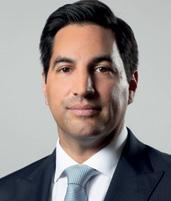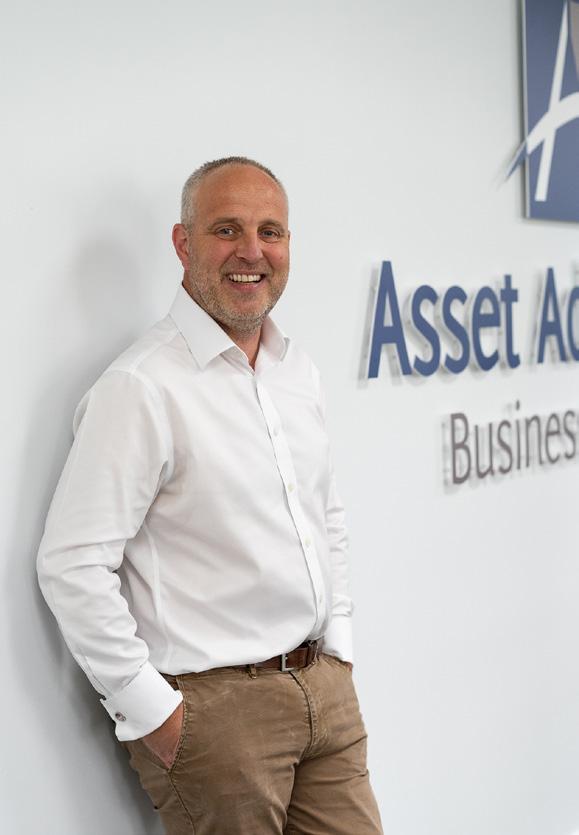Is bridging better or just busier?

+ In-house Powerhouse - p42










































+ In-house Powerhouse - p42








































Editor-in-chief
Beth Fisher
Magazine manager
Dhuha Al-Zaidi
Creative direction
Beth Fisher
Dhuha Al-Zaidi
Sub editor
Christy Lawrance
Contributors
Kiernan Barnden, Chelsea Stewart, Chris Omanyondo, Alastair Hoyne, Martyn Smith, Mark Posniak, Alan Kimber, Jack Coombs, Vic Jannels, Danny Robinson, Jonathan Samuels, Joseph Aston, Shazad Ahmed, Phil Derbyshire, Zuhair Mirza, Adam Stiles, Phil Gray, Adam Tyler, Michael Strange, Colin Anderson, Lorraine Hart, John Symons, Lewis Casserley, Richard Tugwell, Jo Breeden, Stuart Benge, Tanya Elmaz, John Phillipou, Duncan Abraham, Danny Waters, Andrea Glasgow, Sam Bryce, Alice Moore, Kunal Mehta, Roz Cawood, Gary Thompson, Justin Trowse
Photography
Connie Burke, Alexander Chai, Carmen Alaimo llustration by Valf
Sales and marketing
Beth Fisher beth@medianett.co.uk
Ellen Townsend ellen@medianett.co.uk
Special thanks
Christy Lawrance, CLComms
Matt Wells SQ1 Team
Printing
The Magazine Printing Company
Design and image editing Jana Rade, impact studios
Bridging & Commercial Magazine is published by Medianett Publishing Ltd
Managing director
Beth Fisher beth@medianett.co.uk 0203 818 0160
Follow us: LinkedIn @Medianett Publishing | Instagram @medianettpublishing
To read about our commitment to the environment and sustainable print publishing, please visit https://bridgingandcommercial.co.uk/page_magazine.
The car finance industry just blew a £8.2bn hole through the argument that weak standards don’t carry consequences. The FCA says more than 14 million car finance agreements may have involved discretionary commission arrangements that weren’t properly disclosed. Now, a compensation bill in the billions is looming—and the real damage may be to trust.
It’s a moment the entire lending sector should pay attention to. Because fast-and-loose standards didn’t just impact borrowers, they left a crater across the industry. Six years ago, we ran a cover story that ruffled a few feathers—asking whether the bridging industry’s low barrier to entry was undermining standards. Back then, some said the bar was too low. Others weren’t even sure there was a bar. This issue, we revisit that question with fresh eyes, a much bigger market, and arguably even more at stake [p50].
Some believe today’s borrowers are more informed, brokers more selective, and lenders more professional. But has the bar only been lifted because the competition forced everyone to put on a better show? While we don’t expect universal agreement, it’s what makes the conversation worth having.
Elsewhere in this issue, we hear from some of the sector’s most influential names on how they’re navigating change and growth while increasing standards.
Maslow Capital’s Mark Posniak shares the thinking behind their lifecycle lending approach, and how using one team is delivering speed and consistency across complex multi-jurisdictional deals and straight-up bridging alike [p30]. Over at Precise, Alan Kimber unpacks how their newly expanded bridging team is meeting shifting borrower needs and what brokers can expect in the second half of the year [p37].
Aspen’s Jack Coombs reveals the firm’s £1bn ambition and how strategic investment in people and infrastructure is getting the lender there [p42]. Together’s Tanya Elmaz speaks frankly about knowledge gaps in the market, the importance of profitable products, and what brokers can expect from leadership changes at the top [p68].
There’s an exclusive with West One’s Danny Waters and Duncan Abraham, who are bringing a bridging mindset into the commercial mortgage space [p76], and Paragon Bank’s John Phillipou walks us through a landmark £100m scheme funding rooftop solar installations across 4,000 SME roofs—with no upfront cost to the businesses [p86].
In his column, BDLA’s Vic Jannels makes a compelling case for proactive fraud detection, launching a new early warning system and urging lenders to flag suspicions sooner, rather than trying to undo the damage later [p66]. Elsewhere, SDKA’s Kunal Mehta provides a timely reminder that brokers must ensure borrowers understand what they are signing up for in order to avoid painful exit wounds [p94].
Ultimately, this issue explores how brokers—now more than ever—are the real gatekeepers of quality. Because if standards have improved, it might be thanks to sharper expectations from them and their clients.
All in all, it’s an issue that wrestles with some uncomfortable questions and doesn’t pretend there are easy answers. But perhaps that’s the point. If bridging is going to evolve, and mature, then we need to keep asking the harder stuff, even when the market’s doing well.
Until next time.
Beth Fisher

3.50% Plus Bank of England base rate from Up to 75% LTV - Residential Up to 70% LTV - Commercial
Loan sizes: £100,000 up to £5,000,000
ESG discounts available to exit fee p.a.
2.00% Arrangement fee, 2.00% Exit fee

4.50% Plus Bank of England base rate from
p.a.
Loan sizes: £100,000 up to £5,000,000 Terms up to 24 months

“We’re
What has the CPSP taught us?
Learning lessons from decades in bridging
Life-cycle lending / OSB’s big bridging push
New positions, upgraded strategy
Six years on, did we raise the bar?
Tackling fraud one tool at a time
Tanya Elmaz / Duncan Abraham and Danny Waters /
John Phillipou
Brokers and loan pathways / Why we need PBSAs /
Breaking down exits
Meet MS Lending Group’s longest serving employee
StreamBank celebrates two years of raising standards /
Missed opportunities for funders
Here’s what you missed, but diarise these instead
Justin Trowse switches sides

When the stakes are high, we’ve got you covered.
We can fund loans up to£7.5m*, so when your clients think big...
So do we!
Fast decisions, truly transparent terms - delivered with a human touch. Discuss your requirements with us, and we'll provide a quick answer:

0117 937 4333 *Need more than £7.5m? Talk to us... Start your application here.


The Certified Practitioner in Specialist Property Finance (CPSP) course was set up by the Financial Intermediary and Broker Association (FIBA), the Bridging and Development Lenders Association (BDLA) and the London Institute of Banking and Finance (LIBF) in 2023 to educate brokers and raise standards in the specialist finance industry. While not mandatory, more than 1,000 property professionals have registered for the course and hundreds have qualified to date. We ask experts how undertaking the course has enhanced their knowledge and customer service, and how valuable it has proved to be
Kieran Barnden Bridging and commercial team leader at Brilliant Solutions

I wanted to expand my knowledge in the specialist mortgage market and ensure I could provide the highest level of advice to my clients. The CPSP process was thorough but very rewarding, and it gave me the chance to step back, consolidate my experience and sharpen my technical understanding further.
Chelsea Stewart Associate broker at Property Finance Group
At 24, I knew I wanted to establish credibility early in my career and demonstrate commitment to the specialist finance industry. Coming from a lending background, I felt it was important to build a solid technical foundation before stepping into brokering. The CPSP gave me structured learning and context that tied together the product knowledge I had from lending with a broader understanding of the market. The process was rigorous but clear, and I enjoyed being able to immediately apply what I was learning to real-world scenarios.

Chris Omanyondo Mortgage adviser at Visionary Finance
Before entering the mortgage space, I had completed my CeMAP but was eager to demonstrate to both myself and prospective employers that I could tackle more complex areas of finance. The course rewarded me with knowledge and a solid understanding of areas of lending that relatively few hold and also paved the way to my current role as a specialist adviser. The course was seamless with clear, relevant explanations on each topic.


Alastair Hoyne CEO at Finanze Capital
Despite being known in the specialist property finance space for having launched my own custom products and designed new property strategies with the finance that supported them, when the CPSP was launched I realised I had to affirm my knowledge and expertise with this exam. I already had the CeMAP [certificate in mortgage advice and practice], but this was an extra qualification that would add further credibility to my personal brand strength. Likewise, for clients who hadn’t used me previously, this was an additional set of letters to add to my name to provide the confidence that they would know I was an expert in this field. The process was very straightforward for me and, given my experience in the field, I was able to quickly scan the textbook and pass the exam after a single read in May 2024.
Alastair Hoyne CEO at Finanze Capital
My own approach to the role has not changed. But I make the CPSP a requirement for all my team, no matter the function, as I believe it provides a thorough grounding in specialist property finance, which is our core focus. More knowledge is never a bad thing. The CPSP as a foundation paves the way for the enhanced training we provide internally, given our nature as a product-structuring house. After all, our standard model works on the basis that, if we don’t already have the capability to service our client, we build a custom product/strategy for their needs.



Kieran Barnden Bridging and commercial team leader at Brilliant Solutions
It has given me added confidence when navigating complex cases and has enhanced the way I communicate solutions. Clients can see the benefit of the additional expertise while colleagues value the structured approach the qualification encourages.
Chelsea Stewart Associate broker at Property Finance Group
It’s given me extra confidence in client conversations, particularly when explaining complex structures or walking them through niche products. The qualification gave me a deeper appreciation of compliance and risk considerations, which has strengthened how I collaborate with lenders and colleagues internally.

Chris Omanyondo Mortgage adviser at Visionary Finance
The foundational knowledge it provided me with when entering specialist finance was invaluable, as I was unfazed by the fog of technical jargon when discussing cases with new clients and when learning from more experienced colleagues. This boosted my productivity in both performing and learning my role.
Alastair Hoyne CEO at Finanze Capital
Definitely. As mentioned, it provides a thorough grounding to the specialist property finance sector and is far more in depth than the training provided for our sector versus the CeMAP, which only covers the BTL, bridging and development sectors lightly. Commercial property finance isn’t simply a case of going to an aggregator platform and selecting a loan—you need a deep understanding of your clients’ needs to be able to recommend the appropriate products and select the right lenders. To be able to do that, you need to know what you are doing. The CPSP starts you off competently on that transition from the more vanilla regulated mortgage arena to specialist short-term finance.

Chelsea Stewart Associate broker at Property Finance Group
Definitely. Beyond the knowledge, I think the biggest value is the credibility it gives you with both lenders and clients. It demonstrates professionalism and shows that you’ve invested in doing the job properly. For new brokers in particular, it fast-tracks your learning curve and gives you a framework that you can then build on through real scenarios. It’s not a shortcut but a solid stepping stone to developing into a trusted broker.

Kieran Barnden Bridging and commercial team leader at Brilliant Solutions

Absolutely. It is a real differentiator in the market. Brokers gain not just technical knowledge but also a framework for handling specialist cases more effectively and, ultimately, improving client outcomes and building stronger professional credibility.
RECOMMEND

Chris Omanyondo Mortgage adviser at Visionary Finance
I would certainly recommend the CPSP to other brokers to expand their capabilities and understanding of complex, multi-faceted lending. Investment solutions often flow into one another, so having a broad understanding is crucial. As an example, a client could release equity on their residence as a deposit for an auction purchase with a bridging loan, with their exit strategy being refinance onto a BTL mortgage; such a case would require knowledge of topics covered in the course alongside the CeMAP.






Cambridge & Counties Bank is proving that sustainability and specialist lending can go hand in hand, in a market where speed, pragmatism, and partnership define success. As one of the UK’s few B Corp-certified business banks, we’re proud to be using finance as a force for good – not just for our customers, but for our colleagues, communities, and the environment.
A relationship-led approach that brokers trust
Our lending ethos is built around real relationships. Brokers tell us they value our flexibility, responsiveness, and willingness to look beyond the numbers, and our customer stories speak volumes.
Take the semi-commercial mortgage we completed with Mighty Oak Business Finance. The deal involved planning conditions, a newly formed tenant company, and the risk of significant penalty fees from the client’s existing investors. Thanks to our pragmatic underwriting and storybook lending approach, we got the deal over the line, delivering a better outcome for the broker and their client.
Or the loan we provided to The Growforward Project to purchase the former Chelfham School site in North Devon. This complex community-led initiative will transform a derelict site into a wellbeing retreat, café, and heritage centre. It’s a perfect example of how our lending supports regeneration and social impact.
Broker engagement: Built around you
We know that brokers are the heartbeat of the bridging and commercial finance market. That’s why we’ve invested in expanding our regional footprint, opening new o ces in Manchester and Reading to provide faster, more localised support. Our regional directors are empowered to make decisions quickly, and our underwriting teams work closely with brokers to deliver tailored solutions.
We also o er direct access to decision-makers, ensuring that brokers can speak to someone who understands the deal, not just the data. This relationship-led model is what sets us apart and continues to drive repeat business and referrals.
As the financial landscape evolves toward greener practices, we’re proud to support brokers and borrowers on their journey to more sustainable outcomes. In 2024, we saw a steady rise in loans secured against properties with an EPC rating of E or above — a positive trend that reflects our commitment to improving the energy e ciency of our loan portfolio and reducing the environmental impact of the assets we lend against.
Our collaboration with Twinn Risk Analytics is another step forward. By leveraging advanced flood risk modelling, we’re equipping brokers and borrowers with deeper insights to make smarter, climate-conscious decisions in an increasingly unpredictable environment.
“ Thanks to the Bank’s pragmatism, understanding and ‘story book’ lending approach, we finally got it over the line. I cannot recommend Simon and Cambridge & Counties Bank enough.”
Brian Snape
Mighty Oak Business Finance
B Corp Certification:
More than a badge
In April 2023, we became a certified B Corp, joining a global movement of businesses committed to high standards of social and environmental performance. Our B Impact Score of 92.8 places us well above the sector average, and we’re already preparing for recertification under tougher standards in 2026.
This certification isn’t just about internal culture – it’s about how we lend. We’re proud to be the first UK lender to register simultaneously for the Lending Standards Board’s Business Standards and Asset Finance Standards, demonstrating our commitment to fair, transparent, and responsible lending.
At Cambridge & Counties Bank, we’re committed to reducing our environmental footprint and improving how we measure impact. In 2024, our total emissions were 107.79 tonnes of CO₂e, equating to 0.83 tonnes per £1m revenue. We o set 140 tonnes through UK-based nature projects, including work at the Lowther Estate, giving us greater visibility and connection to the impact we’re supporting.
We also maintained our Investors in the Environment accreditation for the 10th consecutive year, a testament to our long-standing commitment to sustainability.
To further strengthen our approach, we joined the Partnership for Carbon Accounting Financials (PCAF), enabling us to improve how we measure Scope 3 financed emissions — a key step in our journey toward Net Zero.
Every deal we support is backed by a robust governance framework. In 2024, we strengthened ESG oversight, increased the proportion of loans with EPC Grade E or better, and reduced exposure to flood risk. Our Enterprise Risk Management Framework ensures we assess both physical and transition risks, helping brokers and borrowers navigate environmental and regulatory challenges with confi dence.
We’ve seen a meaningful rise in colleague-led community engagement. In 2024, we recorded 276 hours of volunteering and donated £75,000 to charity, supporting initiatives like Stepladder Plus and LEBC. While we’re proud of this progress, we know our colleagues are doing more than we’re
currently capturing, and we’re working to improve how we measure and support their impact.
Internally, we continue to foster an inclusive culture, with 44% of senior management and 50% of board members being women, and our Female Founders initiative helping women-led SMEs grow through mentoring and networking.
Let’s build a better future together
At Cambridge & Counties Bank, we believe that specialist lending can be both commercially e ective and socially responsible. At the heart of it all is our continued support for SMEs — the backbone of the UK economy. Flexible, human-centred banking for SMEs can make a real di erence. Whether you’re a broker looking for a pragmatic partner or a borrower seeking sustainable finance, we’re here to help.



Martyn Smith, CEO at Black & White Bridging, was presented with Bridging & Commercial’s Lifetime Achievement Award this summer for his contribution to the industry over the past 45 years. Here, Martyn discusses trust, how not to annoy brokers, the limits of IT, and the importance of being open and clear
Words by MARTYN SMITH CEO at Black & White Bridging
Be honest and transparent
The integrity of the bridging finance market has been tested over the years and, in some cases that integrity has been found to be wanting. To be successful in bridging, it’s crucial to shake off the stigma of the 1980s and 1990s and place honesty and transparency at the core of your working practices, which I tried to do way back from the years 2000–08. This is crucial not only to individual success but also to the reputation of the industry. We’ve all worked hard to rehabilitate bridging finance as an industry, and we need to continue to work together to maintain the position we have now carved out for ourselves.
The first step is to get your own house in order. You need to assemble a strong team, a team on which you know you can rely. How can you build honesty and transparency into your brand if you can’t trust the person sitting next to you? The only way to keep brokers coming back consistently is with relationships and first-class service, so they know that, whoever they speak to in your team, they will get the same standard of care. I learned the value of having supportive partners early on in my career. It’s been crucial to our success at Black & White Bridging.
From there, aligning with regulatory expectations and best practice in the work you do should be the bare minimum. It’s important to communicate clearly and honestly about your products, your lending criteria and your relationships with funding partners. Hold nothing back. This will help build mutual understanding and respect, not only with the businesses you are dealing with at the back end for funding, but with those who are dealing with you at the front end. Build a reputation as a company that brokers and borrowers can truly rely on and trust. This isn’t just for the sake of appearances. Ambiguity and inconsistency are counterproductive. If brokers are struggling to decipher your lending criteria, you’re missing out on opportunities. Acting with smoke and mirrors isn’t just suspicious and annoying—it’s unacceptable. Brokers want to be able to share options with their clients quickly and easily and have all the details at their disposal to answer any questions without delay. They’re under pressure to deliver and their clients, teetering on the edge of a significant credit agreement, will be looking for chinks in the armour for anything that doesn’t make sense. Clarity is crucial.
To be successful in the lending market you need to consider the needs of the borrower and the broker in tandem. Deliver on the borrower’s needs while recognising the questions that will be being asked of the broker. Good brokers understand and genuinely care about their clients. They take time to build trusted relationships that will keep clients coming back. Arm brokers with the information and resources they need to keep nurturing those relationships. Then they won’t just recommend your products because they are the best fit—although of course that is crucial—they’ll relish working with you because you recognise their role in the process. Take steps to make their job simpler—don’t pass on ambiguities that could risk their relationship with their client.
Bridging finance has come so far. More people are considering a bridging loan as a viable option. They are not put off by the rates (which are clearly going to be higher than a regular mortgage loan and no one pretends otherwise), recognising instead the flexibility and opportunity a short-term loan can provide. As bridging continues to become more mainstream, it is important lenders learn to adapt. More demand
will necessitate more lenders. To cut through will require innovation, flexible terms, new solutions for unusual circumstances and thinking outside the box.
Not only does creativity deliver competitive advantage, but it builds resilience. Having more flexible options at your disposal will put you in a better position should the lending or property market change. It also puts you in a solid position to attract custom from those with more unusual circumstances. Developing a reputation as a brand that can always deliver a truly transparent solution will make you the obvious choice for brokers.
Deliver quickly
Of course, a core characteristic of a successful bridging lender is speed. Bridging deals can be done quickly; that’s a given, especially with auction or residential bridges. And speed is another differentiator that can make a lender stand out as competition increases. With pressure on the whole property transaction process to streamline and cut completion times through digitalisation and data sharing, speed of delivery is becoming a necessity for lenders regardless of product type.
You need both tech and touch
Integrating automated and digital solutions will soon be the only way a lender can compete. Digital underwriting tools, AVMs and AI-driven risk assessments will all help to streamline the process and expedite decision-making and delivery. The key—and this will be the crux of what success looks like in the future—is to not lose sight of people in the process. Striking the right balance between automated efficiency and providing a truly human experience is a challenge we will all continue to face going forwards. It’s going to be about tech and touch.
Don’t hide behind AI
At Black & White, we’re always about people first. A machine can’t build a relationship with your brokers or sympathise with a borrower’s situation. If anything, recognising as a customer that you have been communicating with AI and not a real person does the opposite of instilling trust and respect in a brand. AI might not be smoke and mirrors but it’s still something to hide behind. Adopting time-saving administrative systems is one thing but success relies on people. Open and honest communication, balancing the needs of all parties, creativity and the ability to adapt—all of which relies on a trusted team of colleagues.
Our name says it all
There is a reason Damien Druce [COO] and I rebranded Bath & West to Black & White in 2021; it wasn’t by accident. It’s our mantra, in bringing all the good from our past, insisting on true transparency and ridding ourselves of ambiguity. It’s the only way forward for bridging lenders and the key to success.
“Developing a reputation as a brand that can always deliver a truly transparent solution will make you the obvious choice for brokers”









With better Day One funding, you can get your development off to a flying start.












We know you need to get your project up and running fast, that’s why we o er better Day One funding. From initial terms to credit approval and through to delivery, you’ll always know where you stand.
Whether your project is residential, care or student accommodation we can provide stretched senior loans ranging from £3m to £40m.


Work with a team that’s as committed to your development as you are. Take the Atelier Day One challenge – call us today on 020 7846 0000.




Words by MARK POSNIAK
Managing director, short-term finance (UK and Europe) at Maslow Capital
Life-cycle lending, which covers an investment scheme end to end from acquisition through building works to exit, can tackle time-consuming pain points, provide a planned route map, and means brokers deal with just one team


“We will double down on structuring at speed, from straightforward bridges to multijurisdictional deals, and keep measuring ourselves on what matters to brokers: daysto-decision and days-todrawdown”
Over the past two decades, it’s fair to say that the bridging finance sector has evolved beyond recognition. I know because it was exactly 20 years ago that my bridging journey began.
When I started, it was a small, largely privately funded niche. After the credit crunch, a wave of alternative lenders and fintechs professionalised the market, sharpened pricing and broadened product choice.
Since then, bridging has often been the oil that keeps transactions moving when timing or complexity makes term debt impractical.
Maslow Capital was one such lender, born in the aftermath of the global financial crisis and launching in 2009 when the UK economy was in recession and high-street banks were still nervous about lending.
But those days, while dark, were an opportunity for progressive lenders who were prepared to lend when the banks were not—and who backed borrowers’ risk. Maslow was one such lender.
For all the market’s evolution, frictions persist—and Bridging & Commercial’s experienced readers will know them well. What matters now is how lenders respond.
We’ve done this by investing heavily in moving to a full-lifecycle model, offering bridging, development and bespoke structures designed to tackle the pain points that cost brokers the most time.
Brokers can now experience dealing with a single team and pre-mapped transitions across the whole lifespan of their clients’ investment. In practice, that means fewer resets, clearer accountability, compressed timelines and an exit evidenced from day one.
Maslow is an end-to-end lender that has the capabilities to transition brokers and their clients past five milestones:
• acquire
• enhance
• build
• stabilise
• exit.
A single relationship team with a consistent credit memory avoids resets between lenders and materially compresses timelines—critical in bridging and development where speed is key.
For brokers, a life-cycle model means one credit memory and a single decision chain, so one information pack can travel through the journey with pre-mapped transitions all the way from heads of terms.
This reduces applications and paperwork, tightens timelines and improves predictability, while cross-border files benefit from coordi -
nated valuations, notarial steps and transitions planned from day one.
For clients, fewer resets mean lower frictional costs, faster drawdown and smoother, more efficient outcomes. As risks fall—planning granted, works certified, lettings stabilised—pricing and structure can be adjusted without switching lender.
It also supports faster equity recycling at developer exit and keeps the endgame in view.
A sponsor secures a disused riverside office at auction. A £500,000 bridge completes quickly to take control of the asset. While planning runs, a £250,000 refurbishment facility funds strip-out, surveys and a show flat, lifting value without committing to heavy works.
With planning granted, a £12m stretch-senior development facility delivers a mid-scale residential scheme with ground-floor retail. At practical completion, an £8.5m stabilisation facility supports lease-up and marketing, with interest rolling up against a conservative valuation.
Twelve months later, a £9.5m developer-exit loan refinances the stabilisation balance, releases £7000,000 equity and buys time to secure long-term funding. Our lending solutions team then structures targeted land-remediation finance to unlock a phase-two opportunity on the adjoining plot.
The result: by sequencing third-party reports and pre-agreeing refinance covenants at the start, the journey shaved off days and basis points at each transition.
For property investors, certainty and peace of mind are paramount.
As 2025 draws to a close, our focus for 2026 is clear: faster, transparent decisions; pricing aligned to evidenced risk; and bespoke structures delivered at pace.
We’ll continue our partnership approach, seeking broker and borrower input because those closest to the market sharpen our judgement. We will double down on structuring at speed, from straightforward bridges to multi-jurisdictional deals, and keep measuring ourselves on what matters to brokers: days-to-decision and days-to-drawdown.
Since our launch in 2009, we have evolved into a finance ecosystem with fewer moving parts, faster decisions and the ability to scale with one team as transactions grow in size or complexity.
In 2026 and beyond, that ecosystem will continue to grow, and we are keen to make even more brokers and investors an integral part of it.
You’ve been leading the dedicated bridging team. With bridging up 73%, what do you see as the biggest factors driving that?
We’ve certainly seen an increase in the number of bridging enquiries and overall awareness is growing in terms of how bridging can help overcome certain challenges. This uplift in popularity is also reflected in an increasing number of brokers now tackling bridging cases themselves.
At the start of this year, we launched the dedicated bridging division, which meant we were able to hit the ground running as we had anticipated the increased demand. The bridging team offers specialist bridging expertise to brokers with clients looking at short-term finance options as part of their property investment planning as well as guiding brokers who may be new to bridging and need additional support.
We have a team of field and office-based managers who have extensive bridging knowledge, and working alongside them is a dedicated team of around 40 in-house bridging underwriters. These experts put us in the position to be able to support any bridging case, large or small, regulated or unregulated—we have the ability to cover it all.
In Q2, we also announced the formation of a specialist property solutions team dedicated to supporting brokers and their clients with larger and more intricate cases worth over £5m, including portfolio expansion, property development and complex ownership structures. This team includes experienced underwriters and real estate professionals who can also assist with bridging solutions across both buy-to-let and commercial deals.
More recently, Becky Kidby joined OSB Group (our parent company) as bridging and commercial senior proposition manager and will play a pivotal role in ensuring our bridging range evolves with broker and customer needs. Sarah Millard has taken the reins in bridging underwriting and is already presenting a fresh focus, vigour and determination across the team, with an emphasis on converting applications into completions.
It’s a really exciting time—to see our plans coming to fruition and evidencing all the hard work that goes on is incredibly special. I feel immensely proud and lucky to be leading such a talented team of people.
LF uThis year, Precise set up a dedicated bridging division alongside a team focused on large, complex cases. Alan Kimber, its head of bridging, talks about improving processes and knowledge, and how growing demand for diverse deal types is shaping broker expertise
Have you noticed any emerging borrower needs?
There has been a lot of change in the specialist market space and, as such, investors are diversifying their portfolios to maximise their investments and also to minimise their risk exposure. This has led to changes in broker expertise too as brokers want to be able to support their clients for all their property financing needs so they need to be able to advise accordingly. There are plenty of opportunities to improve product and market knowledge in our industry, which is fantastic to see. We’re certainly seeing that brokers are eager to upskill so that they can help shape the vast range of deals their customers may require, whether that’s bridging, BTL, residential or even commercial—it’s always good to have a wide breadth.
The market shift has been clear, but it’s not just changes in regulation and policy that have led to diversification, but also ongoing challenges around property stock. Professionals in the space are looking at taking on projects to help increase their portfolios as well as margins. Due to this shift, many are looking towards bridging to support works before exiting onto a long-term mortgage solution.
We also must consider the perception of bridging as an option too. Historically, it has been viewed as an expensive way of funding. However, in recent years, the cost of borrowing via bridging has become more affordable and more in reach than ever before. This is making it a more viable option and one that an increasing number of borrowers are looking to explore and use.
Earlier this year, you said the bridging team was going to expand. How does this support the strategy?
Between January and May, we welcomed Davey Gurm, John Bremner and Jodie Worswick as specialist finance account managers and Amit Kumar as an office-based BDM within our dedicated bridging team.
Davey was already part of the OSB Group, moving over from his role in the commercial team, as was John, who was a bridging underwriter with us before making the move into an account manager position. Both have brought their extensive knowledge and experience to their new roles and the wider team.
Davey is focused on bridging opportunities across the London area and John’s background in underwriting has helped us to view cases in a different, more adaptable manner. Jodie joined us as a fresh face to the business and her network and knowledge across the North West of England has been invaluable. Amit has hit the ground running in supporting the whole field-based team and all the brokers too. He really has become the linchpin that holds everything together, which he does with such a professional, calm and confident manner.
Precise has won Bridging Lender of the Year several times. What do you think sets your bridging proposition apart from the competition?
It’s incredibly humbling to have been awarded this accolade a number of times now and, each time, myself and the whole team have felt the same sense of pride. It’s an important accolade and shows the support we give to our broker partners is recognised and valued.
At Precise, I feel we have an amazing mixture of expertise, experience and service as well as a wide product range that we can support on. We’re meeting a clear broker need by having a dedicated bridging team as we help customers access expertise when they need it and strengthen their knowledge. We understand the market and are constantly monitoring changes and trends as well as working closely with brokers to understand their challenges and concerns.
In addition, Precise has the advantage of covering regulated as well as unregulated bridging, meaning we’ve built a strong reputation as a one-stop shop for bridging expertise. However, we would never want to rest on our laurels as the market is always moving—sometimes at quite a pace. It’s important for us to remain agile in our approach so we can flex to meet changing needs.
What kind of feedback are you getting from brokers, and how do you act on it to keep improving?
Feedback from brokers is absolutely crucial to us and we use it to shape our service around the requirements that best supports them. We keep an open dialogue and, off the back of various conversations, we have introduced some really tangible developments such as a combined and condensed agreement in principle process, improved criteria around AVMs (which has helped to speed up caseloads), increased access to bridging experts as well as a developer exit proposition.
“There are plenty of opportunities to improve product and market knowledge in our industry, which is fantastic to see”
All these improvements have been brought in this year, so it proves that we not only welcome feedback but we act on it too, constantly building improvements to the broker and customer journey, making Precise quick and easy to do bridging business with.
Precise’s app, which helps keep brokers updated when away from their desks, has grown in popularity since we launched it just over a year ago. We’ve seen a higher percentage of brokers using the app for bridging case updates, which really shows its worth with the most time critical cases.
How do you work with brokers who may not have used bridging before?
We’re seeing more brokers focusing on expanding their businesses and widening their client offering to include bridging as it really can be a great financial solution in many circumstances. So, of course, brokers need support and what better place to ask than a well-established bridging lender who has excelled in this space for over 10 years?
Whether brokers are doing their very first deal or need more specialist advice, this is where our full UK coverage sales team comes in and where they can really add value.
How do you see OSB Group's bridging lending strategy evolving in the next year?
With changes made throughout the year so far, the team are now perfectly placed to take on all bridging needs. We will always see bridging as a solution for chain breaks but it’s becoming a lot bigger than that.
Our H1 results update showed that, collectively, we achieved a 73% increase in bridging business, and bridging originations hit £331.2m. We consider that to be an incredible achievement and show of commitment to the market. We were also able to share that, as a group, we now have over 19,000 active broker partners, demonstrating the strength of our service and products in the market.
We have advancements up our sleeves that will be coming over the second half of the year to further streamline the bridging process without compromising on expertise and service—so please watch this space.

One application. Two solutions. Zero uncertainty.
Seamlessly move your clients from bridging to term finance with Allica’s new bridge-to-term products: Stabiliser and Improver.


Ground-up development rates from 0.78%pm
Loans from £1m to £15m funded
Internal QS from roof level
Interview
by
DHUHA AL-ZAIDI
As part of its target to lend £1bn, Aspen is launching a groundup bridge-to-let product, the first of its kind. Jack Coombs, newly appointed chief operating officer at S&U (Aspen’s parent company), talks about in-house professional services and lending their own money, and why bridge-to-let is popular and scaling up

Congratulations on your promotion to group COO! How does stepping into this role align with Aspen’s broader vision of becoming a standout lender in the specialist finance space?
Many thanks, while my promotion to chief operating officer at S&U widens my remit to broader Group operations and responsibilities there, my focus is also heavily on Aspen. This promotion is a vote of confidence from Group, and particularly Anthony Coombs, our chairman and Graham Coombs, our deputy chairman, not just in myself but also in the important contribution to Group that Aspen is making, both current and future, and our ambitions within the sector. Aspen now makes up approximately a third of Group profit and we are confident both it, and the wider group, will continue to grow.
You’re forecasting 20% lending growth this financial year, with another 20% targeted for 2026. What gives you the confidence to sustain that pace in a competitive market?
Our funding approach, which is underpinned by our parent company S&U’s strong equity position, gives Aspen tremendous flexibility. This offers us a chance to be creative and to continually launch totally new products to the market.
The financial standing of S&U also ensures that Aspen enjoys a competitive cost of funds
This combination, if we can continue to rise to the opportunity, will enable us to compete as we are fortunate in not having typical funding constraints and, crucially, not having to refer any cases for secondary approval. We always say to brokers, ‘the good news is we lend our own money, the bad news is we lend our own money’, but, jokes aside, this is on balance a big plus.
What’s the wider significance of this leadership shift — in terms of driving growth, innovation, and long-term stability?
I will always be someone who enjoys the relationships in the industry and getting neck deep in deals and that is not really going to change. The additional responsibilities to my role include contributing to operational efficiency and innovation as well as funding across the group and complimenting the existing responsibilities of others. Overall, we are committed to improving and growing the business in a sustainable and responsible way. I am very excited about the future prospect for Aspen and look forward to helping drive that alongside Ed Ahrens, our Aspen CEO and the rest of the senior Aspen team.With £750m lending milestone to date, what strategies will you be implementing to achieve your £1bn lending ambition?
Reaching £750m is a proud milestone—but it’s also a springboard. To achieve £1bn, our focus is on scaling both innovatively and responsibly. We’ll continue to refine our lending processes, strengthen our broker partnerships and further expand and enhance our products. Equally, we’re investing in our people and infrastructure, ensuring we can handle volume without compromising speed or service. We’re confident we’ll reach the £1bn mark early next year.
Your bridge-to-let product has doubled in both deal volume and lending. What’s behind that?
Our bridge-to-let has been increasingly popular over the last 12 months because it offers a rare combination of flexibility and certainty.
It is suitable for foreign nationals who are served notice to complete on new-build developments so need a bridge to complete quickly using our no valuation service and who also want the three-year certainty we can offer them.
It is also ideal for heavy works projects where a developer can take an 80% LTV heavy refurbishment offer with 100% of works funding and then, once the works are done, seamlessly transfer across to the Aspen BTL and have the flexibility to either sell or retain units.
We have found this product has an average loan size of £1.25m; this is driven by the fact that the loan amount is up to £15m net, which allows significant works funding, and no stress testing is applied.
What can brokers expect from your ground-up bridge-to-let product, and is it already available?
The ground-up bridge-to-let product is a totally new offering to the market—as far as we know, no other lender provides it—which gives brokers and their developers a guaranteed, pre-underwritten buy-to-let offer that will match the end balance of their development loan. It is a competitive development loan of up to two years followed a seamless transition, without external revaluation or new legals, onto term finance.
The follow-up buy-to-let loan is tailored to the developer’s aims. If they want to sell, it is a one-year product with reduced early repayment charges that offers an all-in-cost equivalent to a 0.6% per month development exit.
If they would like to hold the units, then a two-year product is available, serviced at 6.74% per annum, to developers who can then build rent roll and attract stable tenants and, eventually, refinance onto a longer-term product. This offering is the perfect safety net for developers who, all too often, are compelled into costly extensions, development exit bridges and suboptimal term products.
This product has just been launched to the market; it has already attracted new brokers and developers to Aspen, and we have several progressing deals in the pipeline where developers have opted for this product.
With the recent BDM hires in the Midlands and North growing Aspen's headcount to 31, what do you hope to achieve in those regions?
We have always lent across England and Wales without geographical restrictions. However, previously, we did not have specifically dedicated sales personnel to offer brokers in the Midlands and North. Since appointing dedicated BDM’s here we are now seeing a real uptick in our transactions with several leading firms in these regions. Often, we find the deals we are looking at are not limited to the region the broker is from and the move has generally boosted our lending across the country.
You’ve added dual legal representation with no valuation and expanded your solicitor panel. How will this impact speed, service and broker confidence in Aspen?
Some brokers and borrowers want the certainty and control that dual representation offers. Having combined it with a heavy use of title insurances and Docusign, there is ample opportunity to speed up the legal process. This approach is giving our customers a faster, cost-effective service and we have already completed our first dual representation case in under a week.
We are offering dual representation on all purchases and refinances as well as light refurbishment cases. We will be continually looking to continually improve our legal and other processes as our ambition for growth demands.
WE BELIEVE THIS IN-HOUSE APPROACH WILL OFFER BROKERS AND THEIR DEVELOPER CLIENTS A QUICKER, CHEAPER AND MORE COMMERCIAL SOLUTION THAN BANKS, WHICH ARE RELYING UPON THIRD-PARTY QUANTITY SURVEYORS”
We understand Aspen is hiring an inhouse quantity surveyor in your monitoring team. What is the intent behind this?
We have operated an in-house monitoring team, made up of people with a proven track record in development who can both read a cash flow and plumb, a sink for years. This makes our heavy refurbishment product swift, accessible and cost-effective for developers. The same person appraises then comes back and releases funds, and it happens in 48 hours for a few hundred pounds and funds go directly into the developer’s bank account. It brings borrowers back both to us and the initial broker time and again.
We are looking to bring that same service to our ground-up development offering. We are therefore appointing a RICS-qualified quantity surveyor with a proven track record of appraising ground-up schemes and in project managing them to both appraise and assist with our borrowers’ development projects. We believe this in-house approach will offer brokers and their developer clients a quicker, cheaper and more commercial solution than banks, which rely on third-party quantity surveyors.
This approach means we have less recourse to professional indemnity insurance but, ultimately, that is a decision we are able to take as we principally lend our own funds and we believe that offering a better service together with competitive pricing will reduce our risk by attracting better developers. It may be a tautology but ‘good business is good business’.
As competition in the market increases, what is Aspen doing to get ahead and innovate to ultimately raise the bar?
We are taking several of the support systems around the lending process in-house and, having done this for valuation with our no valuation offering, monitoring and now quantity surveying, we will continue exploring how to offer brokers and borrowers relevant products via a faster and less expensive process. We will continue also to seek to expand the term length and scope of our buy-to-let offerings.













Our reputation has grown from decades of industry expertise, and as an established FTSE 250 business, you’re in safe hands.
We’ve now streamlined how we work, without compromising the specialist knowledge we’re known for. That means we can work with you to find the right deal, at the right price, with the right terms – faster than ever.

Six years after we questioned the state of industry standards, bridging is booming—but has the influx of new lenders and lookalike ‘cheapest and quickest’ products truly raised the bar for quality and professionalism? Brokers and lenders reveal whether progress is real, or just smoke and mirrors

Words
Six years ago, we reported on the flood of new entrants into the bridging market, where setting up a lending firm often took little more than deep pockets, industry connections, and a promise to stand out. Industry voices at the time—both lenders and brokers—sounded the alarm, warning that the low barrier to entry risked diluting quality and driving down standards.
Since then, the demand for bridging has grown significantly. In Q1 this year, the Bridging and Development Lenders Association (BDLA) recorded that bridging applications surged to £18.34bn, compared to £5.96bn in 2019, reflecting increasing borrower appetite and resilience to macroeconomic circumstances—Brexit, Covid, international conflict, and rising interest rates to name a few. Where bridging was once perceived as a niche product, it has gradually worked itself up to the mainstream pedestal, offering quick gains in a market hungry for speed.
As specialist finance grows in both traction and desirability, we raise the question: has the industry genuinely raised the bar to entry in six years?
In our 2019 ‘The Standards Issue’, we heard from several lenders and brokers that barriers to entry were considerably low. Finance providers argued the market was getting saturated, and competition between them was creeping up. Others encouraged this influx of players and said it helped to raise professionalism and competition, providing a greater range of products and services for borrowers to choose from.
In an effort to truly gauge how far the market has progressed, Bridging & Commercial contacted some of its former interviewees to gauge their opinions and find out whether a higher bar has indeed been set.
“I still believe it is easy for new entrants to come into the short-term lending market. But the level of competition in the sector now, driven by the number of lenders in the field, does mean that, to be successful, lenders need to be exceptional to attract clients,” says Phil Derbyshire, managing director at Goldentree Financial Services.
He explains that clients and brokers won't just gravitate to the cheapest set of loan terms offered to them but will instead demand top service from knowledgeable BDMs and relationship managers. Here, he says it is important that a lender will “add value to a longterm relationship that isn't just transactional, but one where the lender understands the client’s aspirations for their business and supports them in that journey”.
For Richard Tugwell, financial market consultant, existing lenders provide tacit guidance for new entrants. “Established lenders and the success that they have had in growing their businesses post-Covid-19 have provided a template for new lenders. Their actions for growth around faster decision–making and speed to completion has shown newer lenders the way in which they can compete,” he suggests.
“The level of competition in the sector now, driven by the number of lenders in the field, does mean that, to be successful, lenders need to be exceptional to attract clients”
Yet some lenders were quick to point out that a lack of proper checks and due diligence could trigger a race to the bottom, encouraging new entrants more interested in turning a quick profit than in upholding high standards of doing business. It was warned that this could result in charging hidden fees and pulling out of complex deals at the last minute.
One senior finance broker claimed the only requirement to entering the market was “a funding line, a LinkedIn account, and a BDM”. One lender was more blunt: “It’s not so much a case of raising the bar, [it’s] finding it—because there isn’t one.”
This sentiment is shared by Colin Anderson, executive director at LDN Finance. “I believe there is now a benchmark, albeit not a formal one. The unregulated sector is largely shaped by a few dominant players whose lending criteria are setting de facto standards for new entrants. This revolves around LTV expectations, speed of completion, valuation, flexibility, and pricing,” he notes. To Colin, the leading lenders that were around six years ago remain “a key component in defining the shape of the unregulated sector”.
However, for Michael Strange, managing director and founder of Funding 365, the barrier to entry for new lenders are still “exceptionally low”. He argues that the marketplace is already crowded with competitive products, notably across the LTV spectrum. “It is a difficult market for a new entrant to garner traction, given they are unlikely to have any funding advantage or product USP versus the existing lenders,” he adds.
So, if product offerings offer little individuality, questions arise about how lenders differentiate themselves.
“Deal volume is considerably lower than when the article was published and lenders are far more selective about what they are willing to lend on,” observes Danny Robinson, director at Grey Matters Specialist Lending. He claims that this in turn appears to have created a standard market mentality whereby almost all lenders operate in the same way—in terms of both risk and practices. This is “to the point where one could argue the specialist market has


“Many lenders have become very risk-averse and vanilla to the point where you question whether they’re truly in the business of specialist lending at all”
become far too vanilla at a time when complexity of borrower circumstance actually requires a specialist lender to be exactly that—specialist”, he contends.
Shazad Ahmed, director at Elan Property Finance, agrees: “There are now more brokers operating in the specialist space, which means clients are spread more thinly. I do agree that many lenders have become very risk averse and vanilla to the point where you question whether they’re truly in the business of specialist lending at all.”
Michael suggests that institutional funding—which 73% of lenders said had increased in 2024 in Bridging & Commercial’s exclusive ‘UK Annual Bridging Market Survey’ with EY-Parthenon—has enabled “sophisticated process and systems” that have raised the value and quality of products being offered. However, for Danny it is quite the contrary.
“Continued institutional investment from larger financial organisations into the specialist finance arena has impacted the DNA of what specialist lending is and should be—the specialist sector seems to have lost its identity somewhat,” believes Danny.
However, Jo Breeden, managing director at Crystal Specialist Finance, asserts that the widening of the bridging market has generally delivered better outcomes. “Borrowers have benefited from sharper rates and improved transparency/speed, while lenders have received much stronger applicant profiles with new customers who would never have entertained a bridging facility six years-plus ago,” he says. “Brokers and customers undoubtedly have more choice now than ever before.”
However, volume itself does not equate to progress. “Genuine product innovation remains limited, and too many new entrants are arriving without a clear value proposition or unique selling point. The result is an oversupply of similar-looking products and propositions, which risks confusing brokers and diluting the professionalism of the sector,” Jo argues.


Jo explains that, with many near-duplicate products, brokers struggle to distinguish between them, which slows their decision-making and makes advice harder to deliver clearly. In turn, if brokers appear to be “shopping” from a wall of indistinguishable options, it can undermine their advisory expertise and the value they bring to clients—the profession risks being seen as transactional instead of consultative.
This concept of shopping around is also noted by Danny, who claims that lenders “fish in the same pond”, and “only differ in rates or fees, as opposed to criteria enhancements or risk appetite”.
In an industry where brokers are having to adapt their skill set while learning and applying their extensive knowledge on several areas of specialist finance, being able to identify the trustworthy lenders is paramount.
“Brokers need support in identifying which lenders are truly reliable partners and which are simply replicating what’s already out there,” says Jo. Michael adds: “As the industry gets larger, it is clear from online reviews which lenders (and brokers) operate with integrity and which ones do not. This is the best protection that borrowers can have.”
Rising competition is sharpening borrower choice, but it’s also making life tougher for lenders entering the market and raising concerns over slipping due diligence. ‘EY’s 2025 UK Annual Bridging Market Survey’ highlighted that, over the past 12 months, 70% of lender respondents viewed competition as one of the top trends in the UK bridging finance market. It was also recorded as one of the top three challenges finance firms faced this year.
According to the BDLA, bridging loan completions stood at £3.99bn in 2019. Now, it’s at a record £13.1bn—arguably an indication of rising

new bridging lenders and growing borrower appetite. However, without a clear USP, lenders risk being left behind.
“If a lender doesn't have a USP and they're a new entrant, then they're going to really struggle in this market,” says Jonathan Samuels, CEO at Octane Capital. “There are already a lot of different lenders, and a lot of needs are being serviced already. Why would a broker trust a new lender without a USP for one of their important clients?”
As Lorraine Hart, head of credit operations at Roma Finance, notes, in a crowded lending environment, a USP isn’t just about standing out but rather being able to “help guide brokers and borrowers to find the best fit for them”.
“More lenders in the market is never necessarily a bad thing because it provides choice,” says Gavin Diamond, CEO at Inspired Lending. However, he explains that from a broker’s perspective, due diligence is crucial: “They always have to question the lender that they're putting the borrower with in terms of whether that is the right lender for the circumstances of the borrower. What happens if things go wrong?”
Michael emphasised the importance of valuable relationships between intermediaries and lenders. “There’s always space for new vendors to come in if they can forge good relationships, offer good service, and execute transactions—even if the product is no different from a product that existing vendors are offering,” he argues.
However, he cautions that entrants need to set themselves apart in an industry with many reputable firms: “If you haven't got a USP, you're going to be a niche player. In this market, there are too many lenders that have good products, relationships, and services. You’re not going to break that unless you have a very compelling product, meaning loan offering as well as service offering.”
This lack of originality, according to Derbyshire, will only become more prevalent as more lenders seek to set up in the market. “I don't understand how the bridging market sustains so many lenders. I'm very sceptical about new entrants,” adds Phil Gray, managing director at Watts Commercial. He explains that his experience of conducting business with lenders has confirmed this: “If you said to them, ‘Explain to me why you're better than a particular lender’, they can't because they're not and that's the problem. The market's flooded with lenders that just do the same thing.”
Joseph Aston, sales and commercial director at Aria Finance, notes caution: “The challenge is that, when lenders flood the market, offering the same thing, you find it's a race to the bottom.” He observes that new entrants typically focus on deploying capital quickly and argues that the best lenders are those that don’t move quick but prioritise understanding the borrower’s asset management process better. “More so than brokers, the borrowing community needs looking after,” he says.
“My fear is that corners can get cut on process and due diligence. How do we keep in touch with our borrowers? How do we help them exit efficiently, and how do we avoid being super aggressive on fines, charges, or possible repossessions? The low barrier to entry has an impact on borrowers that takes out that debt once they're in the loan, not necessarily in the initial delivery of it,” he asserts.
When questioned on what he means by lenders cutting corners, Joseph says that the rush to get money “out of the door” appears as product innovation, yet there is less due diligence. “Newer lenders may build products that have less due diligence—and that for me is dangerous,” he claims.
I spoke to several brokers to understand how they perceive competition and whether the influx of new bridging lenders is a positive development for choice or a drawback in terms of quality control. The verdict was unequivocal—brokers welcome competition but are less convinced whether lenders are truly fulfilling complex consumer needs.
“As the industry gets larger, it is clear from online reviews which lenders (and brokers) operate with integrity and which ones do not. This is the best protection that borrowers can have”
“Lenders’ risk appetite is so conservative now—and I get why—but it makes it hard,” says Danny. He explains that, nowadays, lenders view the industry-standard 65% LTV as a



“Continued institutional investment from larger financial organisations into the specialist finance arena has impacted the DNA of what specialist lending is and should be—the specialist sector seems to have lost its identity somewhat”
nuanced case and argues that down valuations can make a borrower’s case complicated. “If you get a down valuation now, it adds complexity to your case because you're like, ‘Where am I going to go now?’ You can't then go to another lender that offers a high LTV, because none of them do. It’s even simple things like changing valuations that will make a case complex now, which would have been a vanilla thing six years ago,” he comments.
For Adam Stiles, managing director at Helix Structured Finance, his view is the same: “The only way that a new lender can grab market share is by either having a revolutionary product or making riskier lending decisions,” he suggests.
Jo advises lenders to take the time to speak to brokers and understand why cases fall through gaps and don’t complete. “Importantly, they should be taking action to expand their criteria or improve their processes. We have intelligence which indicates cases that have fallen through the cracks, and I think that the more we can share those examples, the more lenders have decisions to make in terms of the kind of risk they want to they want to accept,” he says.


To stand out from the competition, Jo suggests lenders should raise LTV ratios.
For many lenders, the not-so-secret formula is simple: good products and exceptional service. “You can kind of dig into what you need to do to provide those two things, and there's a lot. But, at the end of the day, those are the only two things that really matter,” says Michael. This includes good funding sources and capital flexibility, as well as a solid team and technology. “Any entrant has to do those two things well to become in any way mainstream.”
For Phil, good service always has a place in the industry, and he pinpoints this as lenders being “honest, straightforward, and upfront” in how they deal with matters. This approach to communication is vital and, for Lorraine, it extends to product awareness: “When new products come out, it’s about making sure they're clear and understandable and that it's easy to see what you're offering. You’ve got to constantly try to innovate and come up with new products and solutions, especially if you see a gap in the market,” she explains.
For Gavin, it comes down to delivery and avoiding a one-size-fits-all approach. “A lot of lenders have what I would call a suite of products, and you have a situation where someone's trying to shoehorn a particular deal into a particular product. Then you get other lenders who say, ‘We don't have a suite of products because, at the end of the day, we are a solutions-based lender’. So, they invite a broker or a borrower to come to them with a particular funding requirement, and they understand what it is that they're looking for and then work with them to try to find the right solution,” he shares.
Gavin also highlights that this level of service differentiates lenders to brokers, who rely on a lender’s reputation and track record to deliver in certain circumstances.
“The lenders that we have the most loyal relationship with tend to be brilliant when it comes to overcoming barriers,” observes Jo. Namely, these are lenders willing to stretch their criteria to meet borrowers’ needs and overcome “escalation”.
After all, it’s all about trust. “Unless a new lender is very sharp on pricing, you probably would use another lender that you would trust, unless they started gaining rave reviews, because maybe I wouldn't want my clients to be the guinea pigs there,” says John Symons, mortgage broker at Curzon Financial.



At MSP Capital, we know that every successful development begins with a bold idea. But ambition alone isn’t enough. It needs the right backing to become reality. That’s why we’ve lowered our rates and enhanced the value we offer, giving you the financial strength and flexibility to bring your vision to life.

For Joseph, lenders that find their niche and stick to it tend to be worthwhile. He recognises the repetitive lender catchphrase of claiming to be the quickest or cheapest and recommends instead that firms look to innovate their systems and processes. For example, he suggests products that reward repeat borrowers: “I’ve seen some good innovation for BMV for new popular asset classes like bridge-to-let, or bridge-to-refurb-to-let. It's harder for new lenders to innovate properly because they generally have less control of their funding lines, which again leads to them having challenges in hitting the market,” he says.
Understanding that the market lacks certain niche elements, Lewis Casserley, principal and co-founder of Albatross Lending Group, has exclusively shared with Bridging & Commercial that the lender is looking to launch complex products with the aim of filling gaps in the market.
“When 95% of the industry is powered by the same capital, breaking that mould becomes the only real USP,” explains Lewis. He admits that the firm had lost its identity over the past two years and, despite being a stable lender, recognises that its business model became less competitive where other lenders pushed boundaries—including over-leveraging, cutting legal corners, and leaning on AVMs to name a few.
Though he cannot share much, Lewis hints that the lender is set to shake up the industry soon. “For us, the investment and pain of the past 24 months is about to pay off. We’ve repositioned Albatross to play in spaces that are genuinely underserved with funding lines that allow us to lend where others simply cannot. That, in our view, is the only way to build something resilient in a market that’s otherwise stuck in a cycle of commoditisation,” he says.
From what we’ve discovered, innovation from some existing and new entrants remains limited. Despite the rise in bridging lending, it appears that borrower needs are still being underserved to an extent, posing risks for both the client and broker, and highlighting the need for a lender that that can meet borrowers’ often unusual requirements.
According to Joseph, client needs are always evolving; “the challenge for borrowers is making sure a product is a fit for them. On the flip side, lenders should match this new wave of needs,” he says.
For example, Jo explains he has seen some deals fall through because of lenders’ criteria—specifically flexibility with LTVs. Adding to Danny’s point about down valuations, he asks: “If the valuation is slightly short, then the challenge we have is: can we get a stretch on the LTV to get to the loan that's required?”
Equally as important is the exit plan. “It’s not just about lending the money then leaving them to it—it should be about providing a high level of service and making sure that you are with them every step of the way,” says Lorraine.
Due diligence has never been more important, and it is up to brokers—whose roles are continuously adapting—to choose the right lender to protect their borrowers. “If you take the well-used phrase about treating customers fairly and having a customer at the heart of everything you do, we place the client with the lender who will provide the client with the best solution,” says Gray. This includes a “tried and tested track record of being able to deliver” in a strict timeframe.
“One thing that really drives me insane is there are certain firms that just use the same lenders over and over again and, from a broker perspective, that’s not necessarily the cheapest deal,” shares John. “We'll always go through the process cost wise, who really should be the best lender that's being recommended here, and work through everyone just to find out who's going to be best financial value overall.”
“In this market, there are too many lenders that have good products, relationships, and services. You’re not going to break that unless you have a very compelling product, meaning loan offering as well as service offering”


Stiles points to the lack of regulation coupled with low levels of experience among some lenders. Consequently,

“I don’t understand how the bridging market sustains so many lenders. I’m very sceptical about new entrants”
picking the wrong lender can have repercussions— and be mentally draining. “I've had a situation where the client got into a bit of a death spiral. The lender wanted to repossess the property, and the client wanted to refinance but, every time they asked for a redemption statement, the lender would take three to five days to provide one, by which time the redemption statement was out of date. It just kept going back and forth,” shares Stiles.
He explains that eventually he worked with the borrower to refinance with the said lender at a higher cost, but the lender failed to respond to his enquiries throughout the process. “There’s no real regulation for this thing,” he says. “There is a danger of lenders coming into the market that are untried and untested, that have no track record. It’s like you are rolling the dice on what the outcome might be or how that lender's going to behave.”
The BDLA is behind the drive to maintain stability and professionalism in the industry and, ultimately, protect borrowers from dealing with shady businesses.
Lenders such as Roma Finance believe that the growing influence of such associations have contributed to improvements in standards. “[The BDLA] requires its members to adhere to strict codes of conduct, ensuring transparency, fair treatment of borrowers, clear disclosures, and robust complaint-handling processes. This has led to a stronger culture of self-regulation and an increasing emphasis on professional standards across the sector,” says Lorraine.
Vic Jannels, CEO at the BDLA, highlighted key steps taken to raise industry standards and build a customer-focused market. A top priority, he says, is tackling fraud, most notably through a new intelligence-sharing platform launched in partnership with fraud prevention specialist Synectics Solutions (see page 66).


This system helps lenders to identify and address suspicious activity at an early stage. “We've been amazingly encouraged by the take-up so far,” expresses Vic. “What we were trying to do was to get to an issue much earlier in the process—in other words, to give our members the ability, if they felt concerned that they were being approached with a fraud, that they were able to establish if other people were being faced with the same issue.” He shares that, since the tool was launched in early August, he has been in contact with around five new lenders who were keen to avoid fraud.
For Zuhair Mirza, CEO at Avamore Capital, the BDLA has played a central role in encouraging collaboration between lenders and brokers to “openly discuss challenges, exchange ideas, and explore practical solutions”. He adds: “Just as importantly, they create a platform for progressing industry standards—whether that’s through sharing best practices or facilitating debate on how the industry should evolve. By strengthening these forums, we create more opportunities for shared learning and constructive progress across the sector.”
As part of a broader push to boost education and professionalism in the sector, the Certified Practitioner in Specialist Property Finance (CPSP) qualification was launched in 2023. The initiative—developed through a collaboration between the BDLA, the London Institute of Banking & Finance (LIBF), and the Financial Intermediary and Broker Association (FIBA)—aims to raise industry standards and enhance the market’s reputation. The e-learning programme covers key areas including bridging, BTL, and development finance. According to former FIBA executive chairman Adam Tyler, registrations have now reached around 1,600.

“Brokers need support in identifying which lenders are truly reliable partners and which are simply replicating what’s already out there”



“ The UK needs a huge dose of deregulation. At this point, it feels like every area of our lives is regulated, and I don’t see this regulation making life better for businesses or the average citizen—quite the opposite in fact”
Whether that means being pushed through educational courses or through an onboarding system, I think the onus is as much on brokers as it is on lenders to find the good from the bad in bridging lending.”
Jonathan agrees: “” He argues that if a new lender appears to be unprofessional, then brokers simply won’t recommend their clients to use them, preventing problems by acting as an unofficial barrier. “When it comes to regulation, there’s no middle ground—you either have it or you don’t. Ultimately, we are self-regulated by the nature of brokers choosing the lenders that they respect and have good experiences with,” he affirms.
“I think regulation can be difficult, and sometimes it just becomes too cumbersome and too burdensome, and you end up with the opposite outcome from what people wanted in the first place,” says Phil. “I do think regulation has a place, but you've got to be careful with it and make sure it does the thing it sets out to achieve.”
For Lorraine, you can have the best of both worlds: “To a degree and, certainly for us, it's about behaving like a regulated lender, while remaining unregulated in terms of fair treatment of borrowers, being clear about you're offering, and behaving in a compliant way,” she explains.


“Most bridging borrowers are investors, not consumers, so regulations would be tricky,” argues Shazad. He suggests that instead, lenders enhance the transparency of their operations. “Whether that’s lenders openly publishing turnaround times and fee structures, or brokers feeding back into shared directories, it’s those small accountability steps that raise standards without breaking the market,” he adds.
Consequently, it is down to brokers to gauge which lender is best placed for their client. And, for many, it’s down to track record and longevity.
“Who is loudest doesn't necessarily mean best,” asserts Joseph. “Brokers must get educated, meet a lot of these lenders, understand how they're funded and where that funding comes from, and what their what their back-end process looks like—before you fall for the ‘we move quickest, I can do this in 24 hours’ type of sales spiel,” he emphasises.
Mortgage adviser Stuart Benge, head of property finance at Millbrook Business Finance, uses the acronym PAPER to help him decide. This breaks questions down into the categories of people, asset, purpose, exit and reputation.
“Longevity plays a significant role. A proven track record gives confidence that a lender can deliver and, while new entrants are considered, it’s only once there is evidence they can perform reliably that we will recommend them,” says Stuart.
Stiles considers lenders as belonging within three tiers. First tier are lenders he’s worked with for a long time so he knows that they’ll get the deal done. Second-tier lenders tend to be those with pricing leverage, and the third tier leaves room for lenders that he hasn’t dealt with before.
For John, performance beats longevity. “I don't care if someone's been going for 20 years; if they've got a track record of letting you down at the 11th hour, then that plays into it as well,” he says. He is willing to work with new entrants as long as they “know what they’re talking about”.
“A core panel of trusted lenders provides security and consistency, while new entrants can add value if they demonstrate reliability and innovation. Testing relationships with straightforward, lower-risk cases is a practical way to assess performance before building trust further,” recommends Stuart.

“It’s the brokers who deal with an array of lenders who ultimately decide what to recommend to their borrowers. They act almost as the guardians of where the deal flow should go”



“I don’t think lender tiering would work; a lender can be brilliant for a very specific deal or client profile, and a nightmare for others. I’ve got lenders on my personal ‘no’ list that other brokers swear by—it’s all about fit, not a universal rating!”
to give clients some more clarity and comfort.” But, like Stiles, he is also cautious of how it would pan out. “I'd just be sceptical of who was doing it, who was paying them, and the validity of the ratings,” he notes.
The verdict is evident: six years on, competition has helped raise standards in the specialist finance industry. Although barriers to entry remain non-existent, the rise in new finance firms and an industry qualification have boosted the quality of service in an aim to stand out from the crowd.
Nonetheless, no one can foresee the future, especially given the unpredictable nature of the lending landscape. Now we raise the ultimate question: if competition subsides, could the standards bar lower again?


“The smart businesses will survive and [the] market will consolidate,” says Lewis. “I’d like to think this means maintaining a new standard for specialist finance, but hopefully by products driven by expertise and not by the sheer competitiveness of the market.”
“Service standards have been raised by investment in technology, systems, and personnel, as well as by continuous customer feedback,” highlights Michael. “Service standards are a function of a company’s systems, processes, and protocols. I do not see why they would deteriorate because of a lack of competition.”
Shazad notes: “Once clients and brokers have experienced higher standards, that becomes the new expectation. The lenders that slip backwards risk losing business fast.”
“The standards set by the market leaders are set high not just to outdo the competition, but also through proper industry professionals having pride in the businesses they’re running and their service to customers and brokers alike. I think and hope that the larger, more established bridging lenders would continue to drive a positive bridging lending culture, even in the absence of newer disruptors,” remarks Joesph.
“I do not see the market getting less competitive because the risk-adjusted returns in bridging remain so strong. Either way, the bar has been set more due to bank funding expectations than due to competition, so I do not see that changing. In my experience, the bridging market has moved forward for years, and this will not change,” says Jonathan.
Richard adds: “The bar has been raised and, with it, so have expectations, so it would be difficult not to offer the improvements that have been seen over the last period. New entrants have seen that transparency and good communication is a great way to do business, and this practice is becoming more embedded all the time.”
According to Vic, lenders using the BDLA’s services will prove resilient: “The bar for specialist lending in our sector is set high and will remain so, even if there is a downturn in overall lending volumes. For lenders who are members of the BDLA, there will be no reduction in standards, regardless of the state of the market. This is why introducers, and the public alike, should always look to use BDLA members first,” he asserts.
Either way, it seems like the industry will do just fine, according to Jo: “The bar in bridging hasn’t been artificially raised—it’s a natural evolution.”
“Even if competition eases, customer expectations, regulatory oversight, and the sector’s professional maturity mean standards won’t drop back. The trajectory is now one of continuous improvement.”

Our reputation has grown from decades of industry expertise, and as an established FTSE 250 business, you’re in safe hands.
We’ve now streamlined how we work, without compromising the specialist knowledge we’re known for. That means we can work with you to find the right deal, at the right price, with the right terms – faster than ever.










A single anomaly in a loan application may not ring many alarm bells—but is often part of a much bigger fraud attempt on several lenders. Sharing suspicions early on will give finance providers a far better chance of stopping fraud in its tracks, and an online platform will support them to do just that
Fraud has always been a threat to bridging and development lenders—but, in 2025, it is an escalating problem that demands a united response. As our sector continues to grow at pace, so too does the opportunity for fraudsters to exploit its speed, complexity and urgency.
“Just recently, during a BDLA members’ meeting, one lender raised a potentially suspicious application. Within minutes, five other lenders confirmed they’d received the same case. One had already issued indicative terms. Thanks to the early warning, that transaction was paused and reviewed, and potentially fraudulent activity stopped in its tracks”
At the Bridging and Development Lenders Association (BDLA), we’ve made fraud prevention one of our core priorities. This is not only because it protects lenders and borrowers alike but also because our credibility as a sector depends on it. The launch of our fraud early warning system, developed in partnership with Synectics Solutions, marks a turning point—a move from reactive defence to proactive collaboration.
The need for action has never been clearer. Fraud is not a distant or theoretical problem. It’s happening now, and it's happening fast. Just recently, during a BDLA members’ meeting, one lender raised a potentially suspicious application. Within minutes, five other lenders confirmed they’d received the same case. One had already issued indicative terms. Thanks to the early warning, that transaction was paused and reviewed, and potentially fraudulent activity stopped in its tracks. It was a powerful illustration of both the scale of the problem and the power of collaboration.
That single incident confirmed what many in the industry have long suspected: fraudsters aren’t targeting lenders in isolation—they’re working the whole market. What might seem like an isolated anomaly is often just one instance of a broader, coordinated attempt. It also proved
something else—that when we share knowledge early, we stand a far better chance of staying ahead of the threat.
In response, the BDLA has launched a real-time, GDPR-compliant, fraud intelligence-sharing platform built specifically for our sector. Developed in partnership with Synectics Solutions (the specialists behind the widely used national SIRA system), this new tool enables lenders to raise alerts when suspicious patterns or anomalies arise and immediately share that intelligence with fellow members.
Here’s how it works in practice. If a lender receives an enquiry where something doesn’t feel right, they can enter a few key details into the platform to see whether others have had similar instincts. This isn’t about labelling a case fraudulent—it’s about providing an early indication that extra caution might be warranted. If other lenders have flagged the same borrower, documentation or set of circumstances, that knowledge may encourage the lender to take a more robust approach to further checks, potentially curtailing attempted fraud before it has the chance to progress.
This isn’t about replacing existing fraud detection technology. Most lenders already use systems such as SIRA as part of their due diligence processes. What’s been missing is a secure mechanism to connect those systems and those suspicions across the market. By enabling early-stage collaboration between lenders, we are breaking down silos and giving the industry a far better chance of preventing fraud before it progresses to formal underwriting.
The timing could not be more critical. In Q2 of this year, bridging loan books surpassed £13bn—a record high that reflects the growing maturity of the sector. But with growth comes visibility, and with visibility comes vulnerability. Fraud attempts are becoming more sophisticated and more frequent. Creating fake borrower profiles, forging documents or developing synthetic identities no longer requires the resources of organised crime. Today, almost anyone with intent and technical ability can attempt to deceive a lender.
This evolution in fraud tactics demands an evolution in our defences. The new early warning platform is built to do just that—to offer a fighting chance against an increasingly nimble and well-equipped threat. It allows lenders to act fast, to compare notes and to take appropriate action before significant damage is done.
While stopping fraudulent cases is the immediate priority, the system brings other meaningful advantages. By identifying high-risk cases early, lenders spend less time progressing deals that ultimately collapse. That means less pressure on underwriting teams, lower operational costs and more resources focused on legitimate borrowers.
There is also wider reputational value. By working together, the industry can demonstrate to regulators, institutional funders and insurers that it takes fraud prevention seriously—and is prepared to invest in protecting itself. In fact, one leading title insurer has already indicated it may reduce premiums for lenders who participate in the system. That’s a clear signal of trust in the platform and a tangible commercial benefit for those who adopt it.
Our decision to partner with Synectics Solutions was deliberate. As the team behind SIRA, Synectics brings a wealth of expertise in fraud prevention—and, more importantly, they understand the distinct dynamics of short-term property lending. They worked with us to create a bespoke solution that reflects the specific challenges of bridging and development finance: speed, complexity and a high degree of intermediation.
Measuring success won’t be done based solely on the number of frauds stopped, although that will be a key indicator. The real success will be defined by how the platform changes behaviour. We want to make it significantly harder for fraudulent applications to reach the point of approval—not just because of better tools but also because of better coordination. If that coordination becomes second nature across the industry, the long-term result will be a safer, stronger market.
The platform is now live and available exclusively to BDLA members. We are encouraging early adopters to begin using it immediately because the system becomes more powerful with each additional participant. For lenders not yet part of the BDLA, this initiative offers a clear reason to join—a practical benefit that directly supports business security and operational resilience.
Fraud prevention is not an individual responsibility. It is a collective imperative. By formalising the instinct to share intelligence into a structured secure, scalable system, the BDLA and its members are taking an essential step forward. Together, we can ensure that the bridging and development market remains not only fast and flexible but also professional, secure and trusted.
Words by VIC JANNELS CEO at the Bridging and Development Lenders Association
OFTEN
NEVER MATCHED.


Words by: DHUHA AL-ZAIDI
Photography by: CONNIE BURKE
Together is expanding and setting up an academy for brokers new to specialist lending. I sit down with Tanya Elmaz, managing director of intermediary sales, to discuss knowledge gaps, profitable products, getting the most out of staff, and a change at the top

September marks significant change; leaves gradually change colours to a burnt orange hue, signalling the start of a cooler yet cosy season. Firms welcome back staff who just a few weeks ago were soaking up the sun in an exotic country.
In essence, change is inevitable. But whether some welcome it, or resist it, is uncertain. For lender Together, change has been endless for months—from reaching £7.9bn loan book heights to significantly expanding their team restructure with new hires.
Leading strategically is Tanya Elmaz, who was recently appointed as managing director of intermediary sales at Together, which she finds “exciting”. In particular, she is looking forward to collaborating with the three new executive hires, namely Cheryl Brough, chief people officer, Dave Sutherland, chief operating officer, and Candice Lott, chief marketing officer.
With the move from director to managing director, Tanya look is forward to bringing forward a broader range of products and working closely with intermediaries. “Being managing director has widened my work to encompass more around the products and the pricing and more control and influence over those types of things, which is really important for sales,” she explains. “Typically, we have been working with packaging brokers but, at the end of last year, we grew to include club and network brokers and more high street/standard type of brokers and then, latterly in the last few months, we have started to involve introducing brokers. So, we've actually got three tiers of brokers and now that allows me to take all those types of brokers under my wing.”
Change requires flexibility, and Tanya reports that Together has adapted its lending strategy to focus on broker support. “We have grown our geographical reach as well. So not only are we focusing on the intermediary market but also we've also broadened how many sales regions that we have by focusing on what we call our hero products,” she says.
“Together offers a number of different products—we're probably unique in our space as we offer regulated and unregulated, with four products in each. Our hero products—those that account for 65% of what we do—are bridging and commercial, so those are the products that we're going to be focusing on in the coming years.”
Tanya clarifies that the lender will still offer the other product sets but will be focusing more on its most productive areas of business. Part of this plan entails a comprehensive education and awareness programme to inform intermediaries how different lenders operate, and making them aware of wider criteria points, policy and process changes.
At the beginning of September, Together announced the start of its broker onboarding academy: an education scheme to support intermediaries and strengthen the lender’s relationships with broker partners. “Brokers have got a tough gig, and it is really hard to keep up with all the different lenders, all the different criteria points as well as understanding everybody's appetite and their rules,” Tanya states. “The education of brokers needs to be continuous and there's always a new flow of brokers as well. It's something that doesn't stop and people like to learn in different ways.”
The programme was set up in response to findings from Together’s bi-annual Voice of Broker survey, which, as its name suggests, asks brokers to state their opinions on the lender’s sales team, products, services and more. Tanya explains that the results led to the curation of the academy, with the purpose of distilling bite-size training for brokers to provide advanced short modular courses.
“There are currently four modules, and there may be space to expand with further modules. If you're a regulated broker, there are certain electives you'll need to take. If you're unregulated, you can pick and choose the modules that you want to learn, and they range from 30 minute to 45-minute sessions. Then you read some information and, once you’ve engaged in that module, there may be something like a quiz or questions to make sure that you understand what you've learned. Once you've qualified and gone through the modules, you will get a CPD certificate,” she explains.
Tanya reiterates that the academy differs from the certified practitioner in specialist property finance qualification as it is designed to educate those entering the industry and introduces what Together offers. “Lenders have a responsibility to keep educating but, at the same time, we change what we do as well, so we're always expanding our flexibility. We’ve got to keep sharing and it's probably the best way to teach brokers by showcasing how we work,” she notes.
She also teases that a separate bridging academy is on the way and, though details cannot be shared yet, she hints that it will teach brokers who are new how to operate in the bridging space.
“We have our monthly training webinars where we allow different brokers from different firms to just plug into a topic that they fancy and just get what they need and learn in whatever topic is useful to them. Then, we are rebranding our resource material on our website, so we’re really coming at it from every angle so that we can hit every touch point for every single different type of broker in the way that they want to learn. There’s so much going on at Together,” she expresses.

“BROKERS HAVE GOT A TOUGH GIG, AND IT IS REALLY HARD TO KEEP UP WITH ALL THE DIFFERENT LENDERS, ALL THE DIFFERENT CRITERIA POINTS, AS WELL AS UNDERSTANDING EVERYBODY’S APPETITE AND THEIR RULES”

“I SEEK TO INFLUENCE
WHERE I CAN, AND IT MEANS THAT I’M ADAPTIVE AND AGILE AND THAT MEANS THAT I’M NEVER FIXED AND CHANGE IS EASY. AND WHEN YOU ARE IN A SPACE WHERE CHANGE IS EASY, NO PROBLEM IS A PROBLEM”
Tanya is optimistic that the education programme will aim to address the lack of specialist finance knowledge. Brokers who are new to bridging and commercial may not understand it fully, she observes. “Brokers will typically work in a way that ‘that product works for that enquiry’ and that's not how we look at things, because we do so many different products and because we do cross charging and we look to build a solution. That is certainly a gap – being able to build a solution from scratch,” she says.
This also results from entrants not quite understanding the full flex of a true specialist lender. Tanya believes. “I think, even at a basic level, there's a gap in sourcing systems. Brokers will go to sourcing systems to look at the available price on certain types of products but, in the bridging space, there haven't been very good sourcing systems for brokers to be able to understand bridging. It's been more of brokers understanding from their own knowledge,” she explains.
Despite gradual advancements in technology—Tanya points to platforms such as Brickflow, which helps brokers source the best value specialist property finance for their clients—it is still not easy for sourcing systems to support intermediaries because of how agile the bridging market is, she emphasises. “We're certainly working with as many brokers as we can to bridge those gaps and I reiterate that we believe it's our responsibility to educate brokers and we're going to continue to do that in as many ways as possible.”
With borrower needs undoubtedly evolving, brokers are increasingly expected to be more versatile and understand the complexities of various financial profiles, Tanya notes.
“There are more people becoming self-employed so understanding how self-employed income works is really important, and borrowers expect brokers to understand that and know it—they certainly expect more and more speed with the way that brokers transact,” she says.
“I think borrowers have more of an expectation of personalised advice. I don't think they're looking for a complete one-stop shop for all financial advice – but that could be a future requirement of wanting to talk to a financial adviser who has knowledge in lots of different areas or at least has a network in lots of different areas that they can go to,” she adds.
In turn, Tanya underlines how brokers’ roles are increasingly adapting. Admittedly, she notes, it is not an easy shift for brokers but evolving borrower needs have shone a spotlight on brokers’ professional knowledge. “Historically, brokers didn't need to be as on the ball with the market as they used to. I think now they have to understand interest rate changes and any changes in regulation or in laws and legislation because customers expect brokers to have knowledge about these types of things. I think there's more for brokers to know based on growing sophistication of customer needs,” she explains.
Being a broker in today’s fast-moving lending market is no easy task, but Tanya offers some tips.
“For me, what makes a standout broker is somebody who gives constructive feedback but offers ideas and solutions as well. We do get lots of feedback from brokers and we do welcome that, but the best feedback are ones that come with a solution,” she says. This could be

offering an alternative to something a lender wants, instead of expressing a dislike of a request. “There's no idea that would be a silly idea or no bit of feedback that wouldn't be welcomed,” she adds.
“From a borrower point of view, brokers need to look after their customers holistically and that means following up and understanding what other financial needs that they've got and being able to give professional advice,” she notes. For example, this could involve referring the client to someone in the broker’s network if they were not able to offer advice.
Rewinding over the past 18–24 months, Tanya shares that Together has significantly expanded its team, with the appointment of two regional sales BDM in Exeter and Liverpool, as well as growing their broker club and network regions, office based BDM and their introducer reach.
“We have all areas of the UK covered and that is to satisfy the number of brokers that we are bringing on every single month. We’re gaining between eight and 10 packaging broker firms every
single month, as well as around 40 club and network, and these are phenomenal numbers of brokers that are interested in using our services,” she shares.
When asked on what she attributes this achievement to, Tanya is proud of the firm’s close working with others. “We like to talk to brokers and, whilst we're developing our technology, we are very appreciative of the fact that bridging specialist lending is a relationship business and you need to talk to people to,” she says.
“LENDERS HAVE A RESPONSIBILITY TO KEEP EDUCATING BUT, AT THE SAME TIME, WE CHANGE WHAT WE DO AS WELL, SO WE’RE ALWAYS EXPANDING OUR FLEXIBILITY. WE’VE GOT TO KEEP SHARING AND IT’S PROBABLY THE BEST WAY TO TEACH BROKERS
SHOWCASING
In addition, she highlights a 50-year history, including surviving volatile lending environments: “We've seen turbulent times, growth and lots of different economic backdrops and geopolitical backdrops as well. We've weathered storms.”
She also boasts of Together’s extensive list of products and its credibility. “We've launched everything. We're not testing the ground with anything. We have deliverability, integrity, track record. These things go a long way and you want to be working with a lender that has that track record,” she affirms.
Curious to learn more about Tanya’s approach to her newfound role, I question Tanya on her approach to leadership—and find out about how to encourage enterprising attitudes while keeping your eye on the main prize.
“I'm an NLP [neuro-linguistic programming] informed leader,” she shares. “About 30 years ago, I embarked on my first NLP training and it's something that I've continued throughout my career for at least 25 years.”
She goes on to explain that NLP-style leaders tap into emotional intelligence and to use persuasive language. “I seek to influence where I can, and it means that I'm adaptive and agile and that means that I'm never fixed and change is easy. And when you are in a space where change is easy, no problem is a problem,” she emphasises.
Keen on getting the best from people for themselves and the company, Tanya often finds herself encouraging her team members to push themselves out of their comfort zones. “If anybody asks me a question, I say, ‘I don't know. What are you going to do about this?’ The initiative needs to be there and that allows people to grow. It's in that space of people not knowing what to do and then having to figure it out and knowing I've got their back if anything goes wrong—that's where people grow really fast,” she says. She emphasises the necessity of “building psychological safety for individuals”, by fostering an environment where opinions and feedback are expressed confidently.
Your targets need to be kept in mind, she notes: “I've always been in sales and therefore I'm goal oriented. On the first of every month, I have a target and have until the end of the month, then I go again. I've been doing that since the age of 12 with my first job and I’m now 50, so setting goals and being visible with how you achieve goals and having a clear direction is just in my DNA.”
With CEO Marc Goldberg set to retire next year, Together sets to enter a period of shifting operations and ambitions. Tanya welcomes disruption but recognises what remains of true value. “When Marc moves on—and we wish him lots of luck, we're really excited for him—lots of people that will be coming through and they’re already showing up. I'm talking about underwriters, operations people, directors,” she says.
“Our focus is always the customer and solutions for them and saying yes to enquiries. So yes, Marc is moving on, but actually this focus is always going to be there. In the way that we work, that bespoke relationship, that entrepreneurial lending, that hunger for growth, that will remain. We have a culture for that at Together and a culture is bigger than one person who will always be there,” she assures.
With the bridging sector establishing strong roots, further investment will be made, and Tanya has an optimistic outlook on what lies ahead. “The prognosis for specialist lending is just upwards, and we know that because consumer needs are changing, including the way that we want to transact,” she says.
“As long as the bridging and commercial market continues to meet those types of needs for consumers and investors, then we will continue to grow.”
As the managing director prepares to welcome a long trajectory of growth and change ahead, we’re certainly keeping an eye out for major announcements on the lender’s horizon. For now, Tanya looks to celebrate her 10-year anniversary at Together.



West One arrived in the commercial mortgage market this summer, piloting a product with a select number of brokers. With the official launch now gone live, Danny Waters, CEO, and Duncan Abraham, regional director for the North, talk about applying a bridging culture to commercial, the new team in Manchester, and what you should always keep in mind

Words by: DHUHA AL-ZAIDI

Duncan Abraham: The pilot started with circa 12 intermediaries, which quite quickly became 30 when word got out that we were looking into the commercial mortgage proposition. The first stage was, for me, to reach out and speak to those intermediaries—a lot of whom I’ve got a really good relationship with—and just ask them what's missing in the market. If we were to enter the commercial mortgage space, what would we need to do to gain significant market share?
So, armed with all that information, myself and the rest of the exec team at West One devised a product that we really felt ticked a lot of their boxes. With that, we needed to provide a service proposition that matched too. Phase two was to then design the product. We created it, sent it out to our pilot partners and gave them early access.
Danny Waters: I think there are some interesting points about the commercial market. Clearly, there's a distinction between banks and non-bank lenders. In my mind, I think the general consensus is that banks have capital advantages over non-bank lenders. But, because of the capital treatment in the commercial market, I think non-bank lenders can be incredibly competitive on price, which gives us an advantage when we're actually designing products.
The usual gap between banks and non-banks, in terms of your residential mortgages, second mortgages and other types of products, is not necessarily so wide in the commercial market. So, that's a great attraction from our perspective because we think that we can be as competitive as some of the challenger banks out there with regards to pricing.
DW: The feedback has been good. As Duncan said, we started with 12 brokers, and that was deliberate. We just wanted to make sure that, if we failed with some of our early processes, it would be in a very contained and controlled environment with partners whom we know intimately across the broader group. When word got out that there was quite an interesting and compelling proposition being delivered by West One, all of the old friends within the industry reached out and asked us if they could have access to the product.
Being a supporter to the intermediary community, we definitely wanted to make sure that the partners who have deep and meaningful relationships with us weren't at a disadvantage early in the roll-out of the product. Thankfully, from my perspective, one of the things we did was hire a very experienced team, and Duncan heads that team. Naturally, the team are highly capable. So those concerns that you naturally have when you're launching a product never really materialised. In actual fact, he launched the product on July 2nd and his first completion was eight days later. In the commercial mortgage market, that is just unheard of.
Part of the reason was that we had a bunch of people anticipating the first case after working behind the scenes to build and test the platforms, so when the first application came in, it was treated as if it were sacred and precious. We had a team of people with no other pipeline to manage, and, therefore, they could accelerate that case through. It was also packaged really well. It was in advanced stages with another lender, and we could offer cheaper pricing.
DA: While we’ve been in pilot phase, we've been working hard behind the scenes, so the pilot brokers haven’t seen this, but we’ve been making little tweaks to processes and some additional hires. We wanted to make sure that the proposition we were offering at the trial phase—which, as per Danny's point, has been getting some excellent feedback—was something we could sustain when we go into full launch.
So we've been doing that in the background, and we feel full launch will be ready at the beginning of October. We would have liked to have done it a little bit sooner, but we just wanted to make sure that we had the right number of colleagues in place, because the last thing we wanted to do was launch a product that wasn't ready.
This is now ready for full market launch. We feel it's ultra-competitive in terms of rate and service. And going back to the original point about the trial and what the brokers were looking for, we felt that there was a real gap in the market for someone who was competitive on both price and service. And I feel—and I know Danny agrees with this—that what we have produced now fills that gap.
DW: It'll be interesting because, when we take a step back and we look at the market that we are observing with the possibility of entering it, what are the things that we're seeking? First, we want to know: what's the size of the market? The commercial mortgage market is pretty big. It's probably got fewer participants than some of the other, more congested spaces within the specialist finance space. And that is for a couple of reasons.
Financing is more difficult in the commercial mortgage market, so how will we raise our capital? For the banks, it's more expensive than other, more vanilla products. And then there's also the expertise that's required due to the asset volatility compared with the residential property market.
My belief, when we were looking at this, was that there are many pretty good market participants, but I think they're all a bit bloated. And my thesis is, if we can take the kind of energy and the dynamism that we have within the rest of our business, bearing in mind that the heritage of our lending products comes from bridging finance, then we will be in a really good place to address the commercial market and bring something different to it.
And I think the firm has lots of experience in the commercial mortgage market. We've originated over £1bn of commercial mortgages, but they've all been short, not long-term. Using that experience, using our intellect and being able to understand and underwrite really complicated structures effectively serves us well as we move into this market.
DW: I think it's fair to say that, with all pilots, your technology lags behind because it's the most labour-intensive thing that we have to do, and it takes time. Also, across our broader business, we've got six or seven products, and the rest of the group are also utilising IT and developer resources. So, trying to establish a new system or make refinements to an existing system is just time-consuming.
I think we didn't have the confidence to have a broader launch without having the technology support to be able to scale. That's been delivered now, and we're comfortable—we’ve tested that it's in a good place. And Duncan is now trying to get a few more bodies in the business so that we have surplus capacity for the volumes that we're expecting. That launching in the beginning of October is a really exciting for the business.
DZ:
Danny, you
mortgages
describe
the
launch of commercial
as a core component of West One’s growth
strategy.
What
specific
market gaps or borrower needs motivated the move into this area?
DW: It’s a combination of two things: what does the market need? What does the customer need? And it's also a natural extension of the West One product group. What is the next evolution for us? Over the last 10 years, we've rolled out multiple products. For me, the obvious omission in the product range was for the commercial mortgage market. I think it's quite an attractive market, as I've mentioned before.
The competitive landscape is less congested. The margins are actually quite attractive in the space if you can finance yourself really well. And then some of the competitors, the feedback that I hear from brokers in the commercial mortgage market is about immense frustration.
They can pay out bridging finance loans usually in 2–3 weeks, but it takes them 3–4 months to complete the same commercial mortgage transaction. For me, that just doesn't make much sense.
Often, they're the same type of assets, the same type of borrowers; the only real difference is the duration in tenure. It shouldn't just take that amount of time to process and complete mortgage applications. So one of our big opportunities in this market, as I mentioned, is to bring the kind of service delivery that we have in other parts of our business, whether that's bridging, second mortgages, resi or even construction finance, to the commercial mortgage market. I think, if we do that, we win the hearts and minds of the broker community and the customer base.
DZ: Duncan, you joined West One with over 26 years of experience under your belt. Talk us through joining the lender.
DW: There was a brilliant CEO. [laughter]
DA: Aside from that, I’ve been in the industry now for 26–27 years, and I've known West One to be a heavyweight in the sector—full of ambition, full of growth plans and a business I've admired from afar. Danny and I have known each other for quite some time. The business itself is something that I have admired and when the opportunity to join the group came about, it's just one that I knew was the right step for me. It was the right business, under the right leadership.

They gave me the right motivation as well. Being able to start the commercial mortgage proposition, taking it from inception all the way to launch, has been something that I've never done before. So it was the right challenge for me. To open up a new office as well, in Manchester, and to build a new team was just new and invigorating. It was definitely the right thing for me.
DA: I think there’s a commercial opportunity everywhere; however, I think the North West in particular, which is the area I know, is a real hotbed of activity. If you look around Manchester specifically, there are cranes everywhere in and around the city centre and surrounding areas. There is so much development, whether that's housing, apartments, student accommodation and commercial. It's going up everywhere.
That just felt like something we could tap into. Manchester, the North West and the North of England, because of all those opportunities and all that development that I've just described, lean into our entire product offering, we do residential mortgages, development, BTL and bridging. That gave us the opportunity to make Manchester a new place, geographically, for us to grow.
DW: That was tactical for the business, too. If you think about it, we had about 300 colleagues in our Watford-based office. We're a pretty big employer in that local community, and the supply of talent at some point starts to dry up. So, in order to fulfil our growth ambitions, and people are central to that, being able to hire people from a different geographical location gives us more bandwidth as an organisation and potentially more capacity to grow, not just in the commercial mortgage division but also across the entire group.
DZ: What has the Manchester team achieved since the office opened?
DA: Well, we've moved once already, so we've outgrown our first office.
DW: We're really bad planners in terms of office space. [Laughter] We've already upsized the space of the office as we've hired more people to come in.
DA: What we've done is we’ve managed to grow a team, like Danny said, of talented, experienced commercial underwriters and processors. They’ve worked with us to finesse the process. They've brought a lot of experience and broker knowledge and understanding and, from an underwriting perspective, they are really experienced.
What we've done is look at nearly £500m worth of applications in 6–8 weeks’ time. We've completed nearly 10 applications and, as Danny mentioned, the turnaround time that we've been quoted for other lenders in this sector is three months. We shouldn't have completed one yet. We've completed double figures already.
And that's because, A, we've been able to focus on those applications and, B, we've managed to build a process that is fast, reliable and efficient. We're working with a really good solicitor who has the same ethos as
us, which is providing the best service we can for our brokers and our customers. And we've just made sure we're in a really good place so that, when we go into full market launch, we're ready. And that's what Manchester has allowed us to.
DA: First of all, you need to learn. Learn, learn, learn. It's complex, but simple, but you really do need to understand your business' risk appetite, while also having an open mind to every application, because each one is different. Every personal situation is different. Every commercial situation is different.
Having an open mind really helps and, even after 26 years, I develop every day. I'm still learning. Now, sometimes Danny and I will have a conversation about an application, and he'll say something and I’ll go, “I didn’t think of it that way”. It’s being open-minded to that.
Understanding the role of the intermediary, I think, is important in our sector. This means having an acknowledgement of who does what in the process, and understanding the value of the intermediary and what they can bring to the journey. If you understand that, and you work with them and you work with them well, the result for that customer is fantastic. They get a great customer journey. You meet their

requirements, which is exactly what an underwriter’s role should be.
It should be receiving an application and going, “Right, where's the best fit for that applicant?”, and working with the lender and the broker to say, “I can get that now to completion, as quick as possible, as seamlessly as possible, and to fulfil the expectations of the customer”. If you have that in the back of your mind as an underwriter, you'll succeed.
DZ: What's your strategy for managing your team in Manchester now? How do you go about motivating or encouraging them?
DA: First, I've hired a really good team manager, a gentleman called Paul Hughes, with a lot of industry experience. I'm really optimistic about this. It's something new.
The way I made the move and the motivation I have is what all my team have got. Every day, we have a huddle. We talk about this new process, this new product, the fact that we're launching something into the market. I don't have to motivate them. They're already motivated about that message. It's really clear. At our office, it's a buzz of activity. We're hungry for those applications coming in. We want to get them done as quickly and as efficiently as possible. So the team is kind of a little bit self-motivated.
However, the goal has been to get this launched. And, when the full market launch happens, we know that that phone is going to ring and it's going to ring a lot. They're waiting for it. We're all excited about this journey that we're going on. We know the growth plan. It is an ambitious growth plan but we know we've got the right people to achieve that. Everybody's really motivated.
DZ: West One has gone through a lot of developments this year alone, including reaching certain lending milestones. Danny, what do you attribute this success to?
DW: The business has been very successful for a long period of time. It's now developed some real competitive advantages. The cost of our capital as a non-bank lender is probably lower than that of anyone else out there. We've got significant shareholder funds and equity, which gives us advantages as well.
We've got a highly motivated and capable management team; I think we have the best management team in the market. There's also continuity in that management team, which is also important. If you look at our executive team, with the exception of me, who has been around for 20 years, most of the team have been with us for 10, seven, eight years. So we all know each other really well. We're in our rhythm.
Our strategy is clear. Because we have that continuity in the management team, we don't flip-flop. Sometimes what I see in our competitors, particularly when they have a changeover in leadership, is the new guy comes in and wants to do it a different way to the old guy, whereas we're really focused in terms of what our ambition and plan are and we're constantly in execution mode.
I think we bring intensity to our execution versus our peer group. For me, it's not about “this year of achieving milestones”. It’s the platform and the foundations that we've put in place over the last 15 years that allows us to continue to grow at the rate of knots that we do, which is more difficult the bigger you become.

DZ:
DW: It’s difficult to single out one proud achievement. I think, as a business, we probably don't look back and reflect enough. We're constantly looking forward and trying to mark off what the next objective is.
But one that springs to mind from earlier in the year. Our Elstree programme, which is our securitisation—so how we raise capital in the debt capital markets—recorded the tightest securitisation since 2022. And we were the last firm to print at that kind of level. It really just does show and demonstrate what the institutional investor market thinks of our platform and our business. That's always a proud moment when you know investors are backing you above your peer group.
The commercial proposition has also been a proud achievement. It is very early days, and I tend not to get carried away with things early on, but the launch into these markets is a significant commitment for our firm. We open a new office, we hire a bunch of people and we deploy enormous amounts of equity and funding into that market. If you're going to do it, you had better be right.
I think this has been the most seamless product roll-out that our firm has been part of. I attribute that success to the fact that the existing team aren't doing the product extension off the side of their desk. We've brought in a team of specialists, who are supported by the existing
executive team, and they've been able to run with it, which means that we've been able to enter into that market more quickly than we would have anticipated and, also, we've enjoyed instant success, rather than it being a slow burn.
But it's still very early days. We're not getting complacent. And, as with anything that we do, there will be a few twists and turns in the road. The competitors will respond to what we're doing, the market will improve its efficiency and, I think, our entering the market will be a good thing for the specialist finance industry and those who originate commercial mortgages.
from
DW: At the risk of sounding dull, it's more of the same from us. We will continue to be highly ambitious, a consistent lender in the marketplace. What I think you benefit from with West One, and where others might have a slightly different philosophy, is we don't dip in and out of markets. When we've decided that we want to be a participant in a market, we really want to be deeply and meaningfully in it permanently. So I think that introducers will see we continue to have great appetite to support them and their customers and just continue the journey that we're on. I don't think you can be more ambitious or do things differently to what we currently do.
DA: From a commercial perspective, they'll see the launch of a really compelling product and service proposition. That's the first thing. They will see a business that will want to tweak and be flexible and agile in the next 12 months so, where we see an opportunity or a gap, we’ll want to fill it. So, really exciting times for commercial. It might be a little bit bumpy along the way if it goes as well as we hope it will go, but we will be agile. We will bring out better systems and processes in the next 12 months, but brokers will feel that we're aligned with the rest of the West One product offering and the service will be what they’re used to.
DW: What brokers are really starting to see from West One is a virtuous circle that is being created across the product suite. We often have customers who acquire land through bridging finance, develop it through our construction finance proposition and then retain it through either BTL mortgages or long-term commercial mortgages or, indeed, potentially even residential mortgages.
So, having that comprehensive product suite allows us to be a one-stop-shop, and we do cover a lot of needs. And I think if you do that, you manage to forge deeper relationships with the broker community. That trust develops because they're acting with you so frequently across such a product suite that they really understand what your core values are.
. . . IF WE CAN TAKE THE ENERGY AND THE DYNAMISM THAT WE HAVE WITHIN THE REST OF OUR BUSINESS, BEARING IN MIND THAT THE HERITAGE OF OUR LENDING PRODUCTS COMES FROM BRIDGING FINANCE, THEN WE WILL BE IN A REALLY GOOD PLACE TO ADDRESS THE COMMERCIAL MARKET AND BRING SOMETHING DIFFERENT TO IT”





SMEs wanting cheap energy can get rooftop solar panels installed on their buildings with no upfront costs—even if they are a tenant—thanks to Paragon Bank’s partnership with HDM Energies. John Phillipou, managing director of SME lending, talks about financing a product that saves, rather than makes money
Have you ever stopped to think about rooftops? Not the ones which host the odd summer terrace party or bar, but those covered with solar panels that convert sunlight to energy.
Perhaps, like some, it doesn’t cross your mind every day. But for sustainability-conscious lenders like Paragon Bank, harnessing solar energy via roof panels is crucial to helping SMEs save money while supporting the 2030 net zero target.
In late July this year, Paragon Bank and HDM Energies launched a power purchase agreement tailored to SMEs. The scheme— which provides up to £100m in funding—enables businesses to install rooftop solar panels with no upfront costs and have reduced, fixed-rate energy prices over a term of 10–25 years.
The benefits can be reaped immediately, according to John Phillipou, managing director of SME lending at Paragon Bank. For SMEs, which John notes are underserved by traditional energy providers, this partnership marks a new chapter for growth in sustainable lending.
Working with SMEs day in and out, John observes they have a growing need for information on sustainable practices that also prove cost-efficient.
“A lot of companies like the idea of becoming sustainable, but they haven't started that journey—it’s expensive and difficult. So we are very keen to support that green journey for the economy and were looking at partners in terms of how you step into this market,” he shares.
Under the power purchase agreement, SME customers will receive a site survey by HDM Energies, who then fund, supply, install and maintain the solar energy system, ensuring optimal on-site energy generation throughout the life of the contract.
When questioned on why SMEs are underserved by traditional energy providers, John is clear: “It’s uncertainty. The number of people who've gone green in their homes mirrors what's happening in these businesses. And there's an added complication in that a lot of them are tenants in their properties there, so, if they're going to make an addition to the building with technology—batteries on the side, solar panels on the roof, different boilers and systems—a fear that actually you need the landlord involved in that transaction.”

John explains that Paragon was drawn to HDM Energies owing to its credibility and established position in the industry. “One of the big challenges for SMEs is that you don't know who to go with. If you're going to put solar panels on your roof, you're getting 10 leaflets through your door and you’re suddenly bombarded with decisions,” he says.
And for SMEs, investing in technologies and equipment that will last for more than 10 years is a major decision, and this new partnership aims to offer security. “Part of the package that we're organising includes proper maintenance engineers. We want to make sure that this equipment works and, for SMEs, removing that risk is key. They like the idea of investing, but they're scared to invest in case it doesn't work,” he elaborates.
“A lot of companies like the idea of becoming sustainable but they haven’t started that journey—it’s expensive and difficult. So we are very keen to support that green journey for the economy and were looking at partners in terms of how you step into this market”
In such cases, the landlord to key in how the transactions evolve, and consequently, Paragon has adapted its product strategy to include both tenants and landlords. “If you are a landlord and, say, you have a factory roof, and that tenant moves on, it must be more attractive that you can also offer low energy and green footprints to the incoming tenant,” he explains.

“We’ve really focused on bettering our service and getting closer to intermediaries. That’s coincided with some pressure on brokers who really want to be closer to banks and make sure the banks they’re dealing with understand them”
“It’s easier to follow the conventional route and harder to take on sustainable initiatives, but it’s always about doing the right thing”
The demand from SMEs for sustainable financing is apparent but lenders are yet to meet this. For John, it is up to lenders and renewable energy companies to make such transactions smoother.
“From the bank perspective, the main difference is that when we typically lend to companies, they will visit us and say, ‘I need to borrow money from the bank because I'm growing my business’. They might be buying a new machine that will make a product to make them money or buy something like a truck that will deliver goods and make money when you do the renewal,” he summarises.
However, investing in new green loan initiative takes a slightly unconventional turn. “The renewal does not make them any money; however, it saves them money. It reduces their costs. Typically, in banking terms, when we make decisions about who we lend to, we are used to looking at this customer making more profit. It's a different mindset for the bank to have,” he says.
“We’re adapting our credit policy to reverse this thinking. So it's a challenge inside our organisation as well to educate and think differently in balance sheet terms. But what's important is the bottom line—how much money they make and survive, and this is where the lens has changed.
“It’s not just the SMEs—it's the lenders as well who must think differently.”
The lender claims the new loans will offer immediate commercial benefits to sectors such as hospitality, leisure and manufacturing, and John says that the benefits are already being measured.
“With some of these products, when financial directors sit to assess the investment model, they can see how this bit of equipment is making their business more efficient, as their energy bills are dropping quite fast,” he notes.
John also highlights that advancements in technology, particularly in the past 3–4 years, offer analytics built into apps that allow easy tracking of data coming through the business. “It’s showing how much of the energy is going to the national grid, how much is running their business and, more importantly, how much is being carbon offset. All of this data can show a saving, which may not seem important to that business now, but, as government policy evolves, this is going to be key in the future to show you're going to need to think about these initiatives,” he explains.
Although Paragon Bank is not the first to form such partnerships with renewable energy providers, John emphasises the need for industry-wide collaboration to ultimately make an impact. “I welcome it because, if we are going to really make this difference in the economy, we need a wide range of lenders. The market is big, so we do need to widen this and have more lenders comfortable with funding these assets,” he asserts.
Aside from partnering with HDM Energies, Paragon Bank saw a 7.3% increase in SME lending during the first half of its financial year, writing £247m of such loans in the six months to the end of March.
This is up from £230.2m lent out in the same period of 2024, leading to a £853.1m lending loan book.
John attributes this milestone to Paragon’s shifting service towards brokers, who have been a core focus for the bank. “We've really focused on bettering our service and getting closer to intermediaries. That's coincided with some pressure on brokers who really want to be closer to banks and make sure the banks they're dealing with understand them,” he affirms.
John admits that, while the UK market is “ticking over”, Paragon’s success is testament to its practice of hiring experts who relay the lender’s core strategy, which in turn has reduced the back and forth that may impact a brokers’ time. “We want them to really reiterate that knowledge to the clients so that, when clients speak to them, they're not having to explain basic things. I think that that is starting to really pay off now, and people know they can pick up the phone and we won’t spend the first 10 or 15 minutes giving a basic explanation of what our business does,” he claims.
One example of how Paragon improved its service is “heavily investing” in a front-end broker portal system that has significantly improved how data is processed in a transaction.
“Our portal enables a broker or dealer to put in a customer's details of what they're buying, and quite quickly. Not only will it compute how much the monthly payments are—behind the scenes, it's also doing credit checks and bringing through the data into a score-card engine,” John shares. These said technological developments have reportedly reduced approval processing times by 60%.
He goes on to explain that, if a business fits the lenders’ criteria, the case will be automatically approved. If not, the system will identify possible reasons, and this gets passed on to an underwriter who will examine disparities.
The underwriter then considers whether the disparity is critical to the application or if there is room for reconsideration. This approach, John attests, offers a fast service and, in a lending environment where customers may be impatient, this portal aims to offer a more seamless process than its competitors.
What’s more, the system offers additional features such as automated financial crime checks. “That's quite fundamentally different from competitors, because they may say, ‘Yes, your credit is approved for your finance subject to clear financial crime and other checks’,” he reports.
“But you have certain businesses in the UK that have foreign owners, and those owners are in sanctioned countries. We can flush that out at the very start and go back to a customer and say ‘Your deal's approved—however, we are going to need identification for this director, etc. So, from an intermediary perspective, they get a sense of knowing if this deal is doable and they won’t have difficult conversations with that customer later,” he clarifies.
With the first half of the year already promising for Paragon Bank, John says that partnering with HDM Energies is transformative.
“We already work with 16,000 SMEs UK wide, but the basic premise of working with HDM Energies is, if you think of a Hinkley Point, which is the big power station that's taken 10–15 years to build, we are effectively building a nuclear power station using solar panels across 4,000 SMEs’ roofs, and it will create that amount of energy into batteries that the grid can use,” John explains.
“This is quite industry-changing for the economy because, rather than building nuclear power stations, using the roof space we've got, you’re connecting it all up. It's fundamentally different because now, with the technology, you can put the batteries on the side of a warehouse and on the roof and then, when the high demand comes in, in the evening when everyone's watching TV, that can feed the grid.”
John makes the point that if you look out the window now, how many solar panels do you see on the roofs of London? Perhaps not enough. And yet, there are acres of roofs, including on tall concrete blocks, with nothing on them.
“I just think we're missing a trick. No one's going to see the solar panels because they're several storeys up. Now, the reason these builds don't have it is because it's fiddly to finance and get planning permission, and all these other things need to be taken care of. But it's changing,” he asserts.
Finding the right lender is vital for many SMEs. According to John, the trick is to make sure that businesses know where to look.
“I was on a panel last year with the British Business Bank, and there was a tech company, and the founder made 150 phone calls to try to find that first investment before he found a lender who would help him get to the next level,” he shares.
Finding the volume of lenders approached shocking, John says that Paragon vows to be different. “If someone comes to us and they're in any unusual circumstances, we'll work harder to get their deals over the line,” he states.
With the establishment of the partnership, John is optimistic about the prospect of a rise in green initiatives. And, while cost appears to be a common concern, John states that getting to a reasonable cost point starts by growing sustainable financing.
He remains convinced: “It’s easier to follow the conventional route and harder to take on sustainable initiatives, but it's always about doing the right thing.”

Short-term and flexible financing for your clients property projects. From Refurbishments to Regulated Bridging we have fast and flexible solutions.
Highlights include;
• Regulated and unregulated
• Dual-representation: one solicitor for both parties saving time and money
• Refurbishment Bridging up to 85% LTV
• Covering auctions, house-flips and landlord refurbs
• Access to expert support, including Underwriters
• AVMs
Simple, for everyone. LendInvest plc is a public limited company registered in England and Wales (No. 8146929). Registered Office: 4-8 Maple Street, London, W1T 5HD. LendInvest Mortgages and LI Mortgages are registered trading names of LendInvest Loans Limited. LendInvest Loans Limited is authorised and regulated by the Financial Conduct Authority (FRN:737073). LendInvest Loans Limited is a company registered in England & Wales (Company No. 09971600) and is a wholly owned subsidiary of LendInvest plc. Regulated lending is provided via LendInvest Loans Limited (Company No. 09971600). Unregulated lending is provided by LendInvest BTL Limited (Company No. 10845703) and LendInvest Bridge Limited (Company No. 11651573), which are wholly owned subsidiaries of LendInvest plc. Borrowing through LendInvest and its affiliates involves entering into a mortgage contract secured against property. Your property may be repossessed if you do not repay your mortgage in full.
We are a principal development and bridging lender with a forward-thinking approach.
Funding for light, medium or heavy schemes
Can fund the build upfront, at PC or in drawdowns
No Exit Fee regardless of level of works
Development
Flexible on experience
Solution driven equity structures
Flexible on PGs

Ability to step in at any stage of the build Experienced team with strong track record in funding PCDs
Pre-agreed equity release available

Acquisitions and development exits Net Sales proceeds available Lend against market value NOT 180 value
Residential or mixed use - Mainland England & Wales - £250k to £10m loan amounts available







Exits from short-term loans can go horribly wrong. A plethora of assumptions can lead to delays with eye-watering financial penalties. Brokers should ensure borrowers really know what they’re getting into—and that they get the right type of loan in the first place
every bridging application is like a good story; it should have a well-thought-out and achievable beginning, middle and end.
The post-mortem report has just arrived, and a messy exit was responsible for a developer’s bridging loan coming to a sticky end and a much-loved project biting the dust.
It may sound like the latest Netflix drama but it’s not an overdramatic statement to say exits from short-term loans are increasingly fraught with danger.
But first we have to set the scene: bridging is a solutions-based product and the main reasons for its use are chain breaks, investment or auction purchases (which may include building work), heavy refurbishment, refinance or, as has become more prevalent, rebridging.
All these uses have one common thread: attempts to predict a timescale for when a purchase will complete or when works will be finished. These are often based on fiction, not fact.
A myriad of things can go wrong, including labour issues, poor weather, local planning problems, delays to sales, illness—and this is just the tip of the iceberg.
Words by KUNAL MEHTA
Managing director at SDKA
So the plot begins: a property investor or developer, with or without a broker’s advice, has done their research and they require short-term finance.
To bridge or not to bridge? That is the question. A lender should first consider whether bridging is the right product for the applicant or whether term finance is a better solution.
This requires the lender to look at the application in detail and be honest in their assessment, which ultimately can mean a lot of work for nothing. But, as outlined in the Financial Conduct Authority’s principles for businesses, a firm must consider and act in the best interests of their customers.
If a joint decision is made to proceed, the next major consideration is the length of the bridge.
In the financial world, 18–24 months is still classed as short term, and bridging should only be taken if it works for the project over that period.
Over the past 12 months, there has been a rise in products with terms of only 3–6 months. There’s short, and then there’s truly short. This is designed to play into customers’ perceptions that bridging is expensive and needs a quick exit.
With so many factors at play that can delay a project—something that is amplified when time frames are unrealistically short—we introduce another enemy of the applicant: the exit.
The nemesis of the bridging market, the exit, usually encompassing a raft of small print, is where the unforeseen plot twists suddenly come to the fore.
There are lenders within the market who, one day after going over term, will have no hesitation in immediately placing their client onto default rates while subsequently hitting them with fees and penalties. These numbers can be eye-watering in relation to the original loan amount.
Did the lender take proactive steps to engage the client on the exit penalties at the outset and re-engage before the end of the loan term? Here, we start to see who the heroes and villains in the market are.
In every drama, there’s someone who the main character thought was a friend but turns out to be the enemy and, while this may sound dramatic, it is sad to know that unscrupulous practices are a reality in the bridging sector.
So we have triple jeopardy; was bridging needed in the first place, was the loan term suitable, and was the exit understood by the applicant before drawdown?
I strongly believe that bridging should not be a rate-only driven industry. Every element from start to end is of equal importance, and a successful bridge works on all these factors being understood at the outset.
This is why relationships hold the key to the successful conclusion of any bridge—they are the route to a happy ending.
Words by ALICE MOORE
Associate director at Boyer, part of LRG
Arecord number of students are due to start at university or college this autumn: 439,180 were accepted, up 3.1% from 2024, according to UCAS A s highlighted by the Higher Education Statistics Agency (HESA), there were nearly three million students in the UK in 2023–24 and this year’s increase will grow student numbers further.
PBSA is housing specifically designed and developed for students, offering a range of amenities and services tailored to their needs. It has become an increasingly important form of development, delivering not only homes for students but also significant economic benefits to the country.
Alongside rising demand, the imbalance between supply and need in university towns has created a resilient market for PBSA. Universities rarely have the capital to expand their own housing, opening the door for private investment that delivers consistently high occupancy and reliable rental growth. For investors already active in residential or builtto-rent, PBSA also offers diversification, with operational synergies but different and often counter-cyclical demand drivers.
More people are going to university, pushing up demand for student accommodation. This is a growing, reliable area of investment, and allowing permitted development rights for student housing would boost it further
Much of the demand for PBSA is driven by first-year undergraduates and international students. The remainder usually rent privately, with second- and third-year students often living in shared houses or HMOs. These are typically more affordable but add pressure to the already stretched private rented sector (PRS).
Furthermore, the Renters’ Rights Bill is predicted to raise PRS rents further if, as anticipated, many landlords leave the sector. This would increase demand for PBSA at precisely the point where fewer privately rented homes are available, creating further pressure for students.
The Greater London Authority ’s PBSA guidance highlights that a lack of supply across London is resulting in higher rents in the PRS, noting that "current indications suggest a lack of PBSA supply relative to growing numbers
of students [is] contributing to competition and higher rents in the private rental market, especially as this is facing other constraints".
For developers and investors, a significant opportunity lies in the potential to extend permitted development (PD) rights to the student housing sector. Currently, PBSA falls under planning use class sui generis—a term used to categorise buildings that do not fall within a particular use class for the purposes of planning permission. As such, PBSA cannot benefit from any PD routes.
Recent changes to the General Permitted Development Order have already facilitated a significant relaxation in the conversion of a variety of uses to residential, but this does not apply to student housing. Allowing this would be a considerable benefit; while PD is not appropriate for all circumstances, in the right locations, it can speed delivery and bring underused buildings back into productive use, benefiting net-zero objectives and the circular economy.
Given the scale of demand, there is a compelling argument to consider PD rights for dedicated student accommodation where suitable. This would not replace the need for well-designed new schemes, but it would provide a flexible additional route to delivery. University towns and cities with surplus office space, for instance, could see those buildings transformed into high-quality student housing. This could reduce development risk, deliver accommodation faster and minimise the pressure on traditional housing sites.
It is also important to acknowledge the design and quality considerations of PBSA. Modern student accommodation is increasingly sophisticated, with on-site amenities and using sustainable construction methods, and it can unlock challenging brownfield sites which may not be as well suited to residential use. Good design can reduce community opposition, while sustainable features align with wider climate objectives.
PBSA can be an exemplar of energy-efficient development. Because of their scale, schemes can accommodate technologies such as groundsource heat pumps, solar arrays and low-carbon district heating. This helps universities and towns meet decarbonisation goals while lowering long-term running costs for students. Furthermore, sustainability credentials are becoming more of a priority for students and, as a result, we are seeing several PBSA projects
targeting BREEAM outstanding, which goes beyond policy requirements.
Critics often argue that PBSA is an expensive option for students, but well-designed schemes offer affordability benefits too. Managed utilities, security and shared amenities can reduce living costs compared with poorly converted HMOs, where heating bills and maintenance costs often fall heavily on students. Furthermore, new developments in London are required to deliver a proportion of affordable accommodation, and cities outside London are starting to adopt similar approaches.
Beyond housing metrics, the economic impact of students and PBSA is considerable. International students contribute billions of pounds annually through tuition fees and local spending. Universities themselves are anchor institutions, sustaining local economies and driving regeneration in many towns and cities. A shortage of appropriate student housing risks undermining both the attractiveness of UK higher education and the vitality of host communities.
Well-planned PBSA also supports the quality of life for students. Purpose-built schemes generally provide safer, more sustainable and better-managed living environments than adhoc HMO conversions. This reduces pressure on neighbourhoods where family housing is being informally converted to student use, improving community balance.
PBSA also strengthens local supply chains and generates construction employment. Developers, operators and universities create long-term partnerships that continue well beyond the initial build phase. This enduring economic contribution is one reason why many international investors view UK PBSA as a resilient asset class, even during downturns.
The supply-demand imbalance in student housing presents a clear opportunity, and with the Renters’ Rights Bill expected to place further pressure on the PRS, the case for PBSA continues to be strong. The sector is set apart by its resilience—demand rises in downturns, rents and occupancy remain stable, and the internationalisation of higher education continues to expand the market. With record student numbers and a clear economic imperative, a supportive planning policy system is key to meeting anticipated demand for PBSA over the coming years.
“A shortage of appropriate student housing risks undermining both the attractiveness of UK higher education and the vitality of host communities”
Schemes have many interconnected components, where short-term funding plays a key role in supporting longer-term strategies. In response, brokers are now creating structured loan pathways—opening new opportunities for lenders
For a long time, bridging had an image problem. It was seen as the product you turned to only when things went wrong, the “break glass in case of emergency” option for deals at risk of collapse. That perception has shifted dramatically.
Bridging has become a strategic tool for managing complex transactions, repositioning portfolios and unlocking opportunities that would otherwise remain out of reach. Far from being a last resort, it is increasingly built into strategies from the outset.
This evolution matters because it shows not only how bridging has matured but also how brokers have shaped the way it is used. They have demonstrated its flexibility, highlighted its potential and shown clients how it can be deployed proactively to deliver stronger long-term outcomes.
The latest figures from the Bridging and Development Lenders Association show how far the sector has come. Quarter after quarter, new records are being set, with applications continuing to rise. Demand is broadening beyond rescue cases into structured, forward-looking transactions.
That shift reflects both investor appetite and lender innovation. Bridging options have become more sophisticated, with facilities for refurbishment, conversion and portfolio restructuring now firmly in place. At the same time, lenders have invested in propositions that are far more joined up.
The constituents of a property project rarely run in isolation. They often overlap, with short-term funding feeding into longer-term strategies. The days of trying to shoehorn such elements into rigid product boxes are fading.
Today, more lenders are supporting brokers and clients across acquisition, refurbishment, refinance and portfolio reshaping, recognising that bridging, term and development deals are connected and should be structured to work together.
Certainty and clarity are what matter most when a deal has multiple moving parts. The ability to pick up the phone and speak directly to a decision-maker gives brokers the confidence that issues will be resolved, not left hanging.
The sector has made huge strides in this respect. Brokers no longer face days of waiting to reach an underwriter. Open access has become the standard. That accessibility matters. When a case has quirks or a borrower’s structure is unusual, being able to talk it through quickly means solutions are found and progress is maintained.
Listening has improved too. Brokers are on the front line, seeing first-hand where criteria or processes hold back clients. They are vocal about what works and what does not—and rightly so. Broker feedback has shaped a number of recent enhancements at Hampshire Trust Bank.
Words by ANDREA GLASGOW
Sales director (specialist mortgages and bridging finance) at Hampshire Trust Bank
Extending the use of AVMs in bridging has helped reduce friction on straightforward cases, giving brokers clearer outcomes without unnecessary delay.
Strengthening our heavy refurbishment proposition with higher LTVs and more flexible works funding has expanded what brokers can achieve for clients tackling complex projects.
And, with the introduction of Portfolio Edge, we are going further by combining term and bridging in one structure to help portfolio landlords navigate refinancing pressures with greater control.
This is how the market has matured. Being a quality lender is not just about products; it is about dialogue that leads to more flexible and relevant solutions.
Another sign of progress is the sheer level of competition. Competition remains strong, with new entrants recognising the value bridging brings to the wider property ecosystem.
For brokers and borrowers, competition is a good thing. It raises standards and broadens choice. For lenders, it raises the bar. To stand out, it is no longer enough to quote a headline rate.
The real differentiator lies in execution: handling complexity, structuring deals that involve multiple moving parts and staying responsive when circumstances change mid-transaction.
That is why brokers should judge lenders on the hardest cases. Straightforward deals prove very little. What matters is how a lender handles complexity, makes decisions and adapts in real time.
Brokers and loan pathways
None of this works without brokers. They are the ones bringing structure to clients’ strategies, mapping out what happens not just today but also over the next six, 12 or 24 months.
Increasingly, they are building bridging into plans that stretch across multiple stages from acquisition and refurbishment to refinance and portfolio reshaping.
That makes their role more valuable than ever. They are not simply arranging funding; they are designing pathways. With landlords under pressure from regulation such as that in the Renters’ Rights Bill and EPC requirements, alongside refinancing pressures and affordability tests that are reshaping portfolios, that role is only growing.
What brokers need from lenders in this environment is consistency, clarity and support. They do not want to repeat themselves at every stage of a transaction or fight through unnecessary red tape. They want a relationship that recognises the bigger picture and adapts accordingly.
The evolution of bridging is far from finished. We are still only scratching the surface of its potential. As investors’ strategies become more sophisticated, the demand for short-term, flexible funding will only grow.
The challenge for lenders is to keep pace. That means listening to brokers, improving processes and resisting the temptation to stand still. For brokers, it means staying proactive and educating clients on how bridging fits into their strategy, not waiting until a deal has already run into difficulty.
The progress of recent years should be celebrated, but the sector cannot afford complacency. Brokers have raised the bar and lenders must keep pace with clarity, certainty and solutions that stand up to regulation, refinancing pressures and shifting investor needs. Bridging is no longer a back-up plan but a driver of opportunity—and our role is to build on that momentum together.
“Being a quality lender is not just about products; it is about dialogue that leads to more flexible and relevant solutions”

































































AIL Property specialises in delivering a 360° off-plan sales strategy that enables developers to secure exits ahead of practical completion.
With over a decade of experience in the property sector, we provide a comprehensive service designed to support developers at every stage from pre-launch through to completion. Our approach combines market expertise, nationwide reach, and proven results to deliver certainty in even the most competitive markets.
Funding Flexibility
of to only with
Buyer deposits of up to 25% released for development use only with senior debt
Early Sales Strategy
Secure sales pre-completion
Scalable Approach
From 10 to 1,000 units nationwide
With a trusted track record
Partner with AIL Property to support your exit strategy.






369 luxury apartments
Sales performance £527/PSF
Sales performance £525/PSF Oxygen Manchester
172 luxury apartments


29 luxury apartments
Sales performance £920/PS
174 luxury apartments
Sales performance £390/PSF
Two years is not a long time in financial services. Yet for a new lender, it is long enough to know whether you have struck the right chord with brokers. When we launched StreamBank in 2023, the market was crowded, the economy unsettled and expectations of service were already high. If we had not been able to deliver, then frankly, we would still not be here.
Six years ago, when Bridging & Commercial asked whether the sector could raise the bar, bridging was still seen as a niche product. Today, it is firmly in the mainstream.
So, the real question is not whether the sector has raised the bar. It has. The test is how, and what that means for brokers who are guiding clients through deals in 2025.
For me, the biggest shift has been in the attitudes to bridging. It used to be seen as niche or even a last resort. That is no longer true, as we see brokers now treating it as a mainstream tool and clients are more familiar with it too.
The Bridging & Development Lenders Association’s figures show the market at nearly £13bn at the beginning of this year and climbing, which indicates that bridging is becoming a first not a fallback.
Completion times are another improvement. I remember when 6–8 weeks was standard. Now we are talking about four weeks, and often less. We have had cases complete in just five days. I would not say that is the norm, but it shows what can be done when the broker packages the case properly and the lawyers are experienced.
Technology certainly helps, with AVMs, digital ID and e-signatures, but it is still people who make the difference.
What investors are going for
BTL has had a tough run; section 24, EPC rules, rate rises—none of this has helped. So, landlords are looking around. A few years ago, the move was towards HMOs. Now, more of them are diversifying into semi-commercial and commercial property.
This is not just about chasing yield, though higher rents and longer leases are part of it. I think it is also about spreading risk. Commercial property can provide stability and permitted development rights give investors the chance to convert and add value. Because these deals are more complex, they require lenders and brokers who know the details.
brokers want
The brokers I talk to are clear about what matters most. Speed and certainty top the list every time. But there is more to it than that. They want lenders to be transparent about what they can deliver and to stand by it. Nothing frustrates a broker more than terms being changed at the 11th hour.
They also want products that match the reality of today’s market. The 12-month cap on regulated bridging is a good example. In a slower market, forcing exits inside a year does not always work. Some lenders have brought in bridge-to-term products or flexible rollover options to address this, and I think we will see more movement here.
Above all, brokers want support that goes beyond the loan itself. They want a relationship where they can pick up the phone, talk through a case and know they are being heard. That sounds simple, but it makes a big difference.
Intermediaries more involved
Brokers themselves have raised their game, and the best now act more like project managers. They do not just secure the funding and step away but stay close to the deal from start to finish. That means lining up exits before the ink is dry, checking that contractors are in place and making sure the solicitor has handled bridging before.
This approach is reassuring for both the client and the lender. A well-prepared broker, with documents in order and a realistic plan, helps us complete more quickly and with fewer surprises. It is no accident that the fastest deals we have done have involved brokers who were all over the detail from day one.
As a new lender, we had to prove ourselves quickly. We knew that if we did not deliver on speed, on transparency, on consistency, we would be written off as just another entrant. Over the past two years, we have shown that we can do what we say, even when conditions are tough.
One of our early decisions was to build title insurance into our product set. It was not glamorous but it made a real difference to completions. Another was to launch our StreamLined product with a legal fee contribution to take friction out of the process. Those choices came directly from broker feedback and they have helped us gain traction.
But the bigger lesson is that consistency builds trust. Completing one deal quickly is not enough. Brokers want to know that when they come back with the next case, they will get the same service. That is how you move from launch to being seen as an established lender.
Words by ROZ CAWOOD
Streambank was set up in 2023, when both the property market and bridging finance were very different. Looking at how they have changed can give a good indication of the direction of specialist lending
Looking back, the markets of 2018 and 2019 feel very different. Completions were slower, product choice was narrower and collaboration between lenders and brokers was less developed. The progress since then has been clear.
Has the industry raised the bar since Bridging & Commercial ran its ‘Meet me at the Bar’ feature in its 2019 The Standards Issue six years ago? Without question. Service standards are higher, products are more flexible, brokers are better informed and collaboration across the chain is stronger.
But the bar is not fixed. A 32-day completion average today may be 28 tomorrow. Loan books approaching £13bn could be £15bn next year. Pricing pressure is already there. Regulation will continue to develop and, as always, brokers and lenders alike will need to adapt.
The next phase is about balance: keeping the speed and flexibility that bridging is known for, while making sure clients are protected and exits are realistic. It is about lenders supporting brokers with the right products, clear communication and consistency of service. And it is about brokers continuing to take that wider view, managing projects from cradle to grave.
Six years on from that original challenge to raise the bar, the answer is yes—but with a caveat. The bar has moved, and it will keep moving.
For StreamBank, the focus remains the same as it was at launch: speed with certainty, flexibility with support, and partnership for the long run. If the sector keeps delivering on those, we will not just meet the bar—we will help set the next one.


Marking four years at MS Lending Group, Sam Bryce has grown from joining as a business processor in 2021 to becoming an underwriter—and the company’s longest-serving employee. We caught up with him to reflect on the journey so far and what he’s aiming for in the year ahead
What led you to your current role at MSLG, and what key lessons have you learned along the way?
I had previously worked at Together and then took a short break away from the financial services industry. I had seen online about a new lender MS Lending Group, set up by Michael Stratton and they were hiring. I was looking for a new opportunity and something that excited me. I haven’t looked back since. I started as a business processor, at the time there was just Michael, and Alex was building the marketing. I’ve been given the opportunity to touch every part of the business since I started, and get really stuck in. This was pivotal to my learning. As well as the opportunity to work so closely with Michael, learn from him and see how he has built the business.
One of the key lessons I have learned since my time working at MSLG is the importance of building strong relationships, whilst being adaptable in a fast-paced industry and always keeping the bigger picture in mind. Every transaction has its challenges but approaching them with an open mind, and persistence will almost always lead to a solution. Most importantly, I have learnt that communication is just as valuable as technical knowledge. The Bridging industry is just as much about the people as much the deals themselves.
Congratulations on your awards as a standout underwriter! In your view, what qualities or skills set an exceptional underwriter apart?
For me, it's a mixture of commercial awareness, attention to detail and empathy. In my view, a great underwriter doesn't just assess risk in isolation, they understand the borrower's circumstances, the broker's requirements and the lender's appetite, bringing the different elements together to find a solution which benefits everyone involved.
You once mentioned being nervous about calling brokers early in your career. What advice would you give to new underwriters who may feel the same way starting out?
In the beginning, Michael would expose me to so many clients, meetings and conversations that I was able to learn some great skills, putting myself in the shoes of the borrower yet also knowing I’m here to protect the business. Everyone has to begin somewhere, whether it was me moving into an underwriting role, or someone taking a bridge for the first time. I would say, don’t be afraid. Speaking on the phone to borrowers and brokers can seem daunting at first, however
difficult the conversation may be, but Brokers and clients are only looking for the right outcome and they really do appreciate direct, honest communication. It’s very much a people business.
Can you recall the first time you encountered a particularly complex case? How did you approach it then, and what strategies do you use now to manage such challenges?
I remember a case a few years ago which involved over 50 properties, a complex back-to-back purchase structure with a tight deadline. At the time, it felt overwhelming trying to tackle everything at once. However, the right approach was to break it down step by step.
Now, whenever I face a complex case, I focus on three key areas:
1. understanding the borrower’s story is an end goal, 2. communicating Clearly with brokers and internal teams, 3. staying calm and methodical, solving one issue at a time.
My experience has taught me that complex transactions require patience, structure and team work alongside other departments within the business. Whatever seems daunting at the time, once broken down is so much more easily achievable than you think.
Looking ahead, what’s on your “to achieve” list over the next 12 months?
From a professional point of view, I want to keep developing my skills and play a bigger role in shaping processes that make lives easier from brokers and borrowers. I'm keen to continue to build strong relationships across the industry and to be recognised for not just speed and accuracy, but for being approachable and reliable.
On a personal level, I want to keep learning about the wider property and finance industry in order to bring more commercial insight into my role. Ultimately, my goal is to continue growing within MSLG as the business goes from strength to strength.



Welcome to Masthaven Masterclasses - regular webinar sessions designed to give you insight into the people and processes behind specialist finance.
Kicking off our first session, we’ll be focusing on development finance. Join our Head of Development Finance, EJ, and special guest Colin Horton from Project Surveyors, as we take you behind the scenes of the development finance surveying process.
Date: Wednesday 19th November Time: 12pm Presenter: EJ - Head of Development Finance Duration: 60 minutes (inc. Q&A)
Guest Speaker: Colin Horton Project Surveyors

For Intermediaries Only

Register for our Masthaven Masterclass webinar series - a live Q&A, on development finance.
SMEs are struggling to expand and plan because the type of loans they need is often not available. It’s a missed opportunity for funders—they could boost their profits by working with brokers to support these businesses

Gary Thompson
Words by GARY THOMPSON
Sales director at Asset Advantage
When it comes to securing finance for business acquisitions, management buy-outs (MBOs), and buy-ins (MBIs), commercial brokers continue to report that the lending market feels far too narrow. Our latest broker survey identified a concerning trend as brokers once again talk of limited lender appetite, a shortage of options—particularly for smaller transactions—and real difficulties around security and credit requirements.
It's an issue that banks, lenders and funding providers must take seriously as it leaves commercial brokers without options and many good businesses without the finance they need. This funding is critical in supporting SME’s stable growth and ability to make plans. Furthermore, by stifling SME expansion, we risk amplifying the fierce headwinds already hitting a struggling UK economy.
In our latest commercial broker survey, one-third of respondents said that it is difficult to find appetite among lenders for business acquisitions—the same figure as in our 2024 survey. Worse still, the number of brokers finding it hard to secure 100% funding has more than doubled this year, up from 20% of brokers to more than 40%.
In further signs of narrowing, more than two in five brokers believe lenders are not equipped to support smaller acquisitions, with limited funding options to facilitate these transactions. In such an important segment of the market where businesses are perhaps likely to feel the most pressure, it is vital that lenders are able to support smaller transactions and provide what can be both a viable route to growth and an important solution. In our case, at least, it remains a clear priority and an important part of our business.
The frustrations for commercial brokers are real and warranted. Standing at the coalface, they need the tools to be able to support SMEs and get transactions over the line. Without the necessary funding, they can’t complete the deal and risk losing the client entirely. Our survey shows brokers will commonly use asset finance to raise the required funding but, in most cases, it still doesn’t come anywhere near the required amount. Another broker spoke of using invoice finance in an attempt to raise funds.
It’s a massive missed opportunity for funders to support not only their broker partners but also SMEs at a pivotal time for their business and the wider economy.
The latest Business Finance Review from UK Finance shows that gross lending to SMEs has now increased year-on-year for six consecutive quarters, which is hugely positive. However, dig deeper and we see that the pace has slowed—to 8% instead of 14% in the prior quarter. This is attributed to weaker lending growth among medium-sized firms and a contraction of new loan approvals.
What is more encouraging is that, among smaller businesses, there has been an increase in new lending in Q2 by almost 28%. However, we know from our data that this isn’t the story for every business and every case, particularly when it comes to business acquisitions. While perhaps more vanilla cases are able to pass through the system, it is the fundamentally good businesses but with a story behind the deal, or those that stray just outside rigid criteria or risk appetite, where additional support is required.
As SMEs continue to weather fierce economic headwinds, there’s no question that lenders need to keep an open mind. Given the urgent need to boost economic growth, we must also give these critical businesses the confidence to invest, expand and scale. Instead of funding just
“In such an important segment of the market where businesses are perhaps likely to feel the most pressure, it is vital that lenders are able to support smaller transactions and provide what can be both a viable route to growth and an important solution”
short-term needs, we need a platform of accessible, flexible funding to deliver quick, scalable growth and ensure continuity if business owners are looking to exit. Doing so enables management teams to jump on opportunities while also safeguarding jobs.
Without these robust funding lines and appetite from lenders, SMEs are unable to seize these opportunities or successfully manage the life cycle of business ownership, especially when it comes to succession. In short, we’re not just blocking brokers—we are inhibiting the health and prosperity of our SMEs.
While it may be much harder for big retail banks and lenders to deviate, we are in the fortunate position of having a number of more agile and flexible funding providers that are actively closing gaps regarding both appetite and risk. We need funders like this, which are not only focused on growth and expansion but also open-minded and forward-thinking in their approach to lending.
It’s the sentiment we hear from commercial brokers—urging the market to move away from strict criteria to a more pragmatic, holistic approach. Listening to brokers on the ground is imperative to informing lender practices and making sure funders are meeting the needs of the market. That could be a greater appetite for business acquisitions, MBOs and MBIs, the provision of 100% funding or more support for smaller transactions, such as in our case with 100% funding and loans from as small as £75,000 to right up to £1m. Many business acquisition loans start at £2m, which means many SMEs are underserved.
In our experience, business acquisitions are a significant growth area for us and our broker partners, with high demand for growth and expansion funding. As the business landscape in the UK continues to shift and SMEs require additional support, it will be lenders who work closely with brokers, helping them to guide their clients through this process, that will enable SMEs to survive, thrive, adapt and succeed.
“This was another great event that brought people from across the property sector together in aid of two brilliant charities in our heartland. Every year the championships serve as an opportunity for us to give back to the community in a way that enables people to have fun and network on the sand,”
- Leigh Bartlett, chief executive of MSP Capital




“Thank you to every single competitor who took part and all the companies that entered teams. Once again, everyone had a great time and got into the competitive spirit all in support of Lewis-Manning and Julia’s House,”
- Rachel Bartlett, MSP Capital’s head of marketing and people
Caroline Attreed, Corporate Fundraiser for Julia’s House, a Dorset and Wiltshire children’s hospice which provides specialist care to those with life-limiting and complex conditions, said: “The work that MSP Capital puts into this competition is phenomenal. It is such a great local event, bringing businesses together to have fun while making such a difference to their local community. The donation raised helps Julia’s House to bring clinical care, fun, laughter and compassion to the children we support. And to give exhausted parents a much-needed respite break from around-the-clock care, with the peace of mind that their child is in safe hands.”





Vicki Gray, head of fundraising at Dorset-based Lewis-Manning Hospice Care, an independent charity that supports local people and their families facing a life-limiting illness, said: “The beach volleyball event is always such an amazing day, loads of fun, a bit of friendly competition, and a chance for local businesses to connect. But most importantly, it helps raise awareness and support for two amazing local hospice charities. The funds raised will go a long way towards helping provide hospice care to those who need it. Huge credit to MSP Capital for organising another incredibly successful event. Every organisation and player involved has really helped make a big difference to so many people in our community.”



On 4th September, MSP Capital kick-started the month with a volleyball tournament to raise money for Julia’s House Children’s Hospice and Lewis Manning Hospice Care
In total, the lender was joined by 20 teams, from the likes of AECOM, Blake Morgan, Clarke Willmott, Ellis Jones, Frettens Solicitors, Imperial Homes, Interpath Advisory, Lester Aldridge LLP, Porter Dodson, Preston Redman, Quay Crew, Quostar, RSM, Rubicon, Saffery LLP, Travers Smith, Trethowans, Vail Williams, Venture Recruitment and Wellington King. RSM won following a final match between them and Interpath Advisory.







Ladies, explore the upcoming events coming your way
Wednesday 29th October
SIP & CONNECT: CHEESE & WINE
Venue: Boss Design, 7 Clerkenwell Road, EC1M 5PA. Times: 6 – 9 pm.
sip & connect is an evening networking event for females across the property sector. At this event you can expect cheese, wine and a friendly environment to network, chat and make meaningful connections with other like-minded women in the property sector.
Wednesday 12th November
SIP & CHIP – KEEP AN EYE OUT AS TICKETS WILL BE RELEASED SOON.
Venue: Greenwich Peninsula Golf Range. Times: 6 – 9 pm.
This event will include a group golf lesson with a pro at the Peninsula with drinks and networking.

Wednesday 19th November
SIP & BRUNCH - KEEP AN EYE OUT AS TICKETS WILL BE RELEASED SOON.
Venue: Hunters Contracts, 8-10 Charterhouse Bldgs, London EC1M 7AN Times: 8 – 10 am
This event will be a breakfast networking event with Pret breakfast pots, bucks fizz, coffee/tea and casual networking before the working day!
What is sip (sisters in property)?
sip is your new girl’s group chat—a relaxed, female network designed to foster genuine connections and meaningful conversations.
Who can attend?
This network is aimed at female professionals with under 10 years of experience in the property field. Whether you're just starting your career or looking to grow and form an amazing network, we want to create a space for women to come together, support each other, and build both personal and professional connections in and outside of the workplace.
Get connected!
sip LinkedIn: @sip sip Instagram: @sipnetworks



after steering Allica Bank’s entry into the bridging market and overseeing its Tuscan Capital acquisition, Justin Trowse has made the move from lender to broker. Now managing director of debt advisory at Mortimer Street Capital, he’s bringing his experience to the other side of the table.
You’d successfully launched Allica’s bridging proposition and overseen the Tuscan Capital integration — why was that the moment to walk away?
I’ve been fortunate to launch and grow some exciting ventures over the years, and it felt like the perfect time to take those experiences and channel them into something new. I was ready for a fresh challenge, to step away from the lender side and focus on building something of my own. It was both a natural next step and an opportunity to create something meaningful on my own terms.
What’s the single biggest difference you’ve felt in crossing from lender to broker?
As a lender, you’re usually focused on developing and protecting your own book. As a broker, you’re dealing with multiple lenders and constant market changes. The variety and pace are very different you must stay sharp and lean on strong relationships to stay ahead.

What’s it like returning to that ‘hustle stage’ after running whole departments?
The drive is still there, but now it’s sharper, faster, and much more personal. As a lender, the hustle meant deep project work and navigating internal processes to win board approval. Now, as a broker and business owner, it’s about getting out there, connecting with clients, tapping into networks, and pushing deals over the line. It’s a different kind of hustle, but one that feels more immediate and rewarding.
If you weren’t in finance, what completely different career would you have chosen for yourself?
Fighter jet pilot, if they’d have me.
What’s your go-to comfort meal?
A good slap-up Indian curry.
If you could live in any city in the world for a year, where would you choose?
Having sat on both sides of the table, what specific edge does that give you when advising clients?
The edge is knowing exactly how credit teams think. We have experience in writing credit papers, breaking down development appraisals and business plans, and positioning a deal the way a credit committee wants to see it. Collectively, we’ve overseen £2bn-plus of deals, so there’s very little in short-term finance we haven’t seen which helps clients get faster approvals and terms that stick.
What traits do you look for in a good lender? What makes certain lenders appealing?
For me, trust in the originator and their team outweighs a few basis points on commercial terms. It comes down to responsiveness, straight dealing, and understanding the deal from the start if I have conviction in those traits, that lender will get our recommendation.
How do you plan to make Mortimer Street Capital stand out in what’s becoming a very crowded bridging space?
With the rise of bridging over the past decade, there’s no shortage of capital or brokers in the market. However, I believe the standards and experience of both remain fairly ‘green’. That’s why there’s such a noticeable gap between the top lenders and brokers and the pack behind them. Mortimer Street Capital will stand out because of our depth of experience; we’ve been on both the advisory and lending side for over a decade, and there’s very little in the short-term finance market we haven’t seen.
On top of that, we’re investing heavily in people, technology, and brand from day one, giving us the infrastructure and credibility to compete at the highest level right from the start.
You said growth targets are “aggressive” — what does this look like in practice?
For us, ‘aggressive’ means building visibility and credibility in year one, not year five. We’re targeting rapid deal flow, strong lender partnerships, and brand recognition from the outset. That takes proactive marketing, long hours, and a relentless pipeline mentality, with the ambition of being mentioned alongside established players far sooner than most would expect.
New York for the hustle, Miami for the sunshine — and both are perfect bases if you fancy jumping on a plane to anywhere else.

Low rates. Dedicated team. Keep the ball rolling.

To find out more, call 0800 116 4385.
Intermediaries only.